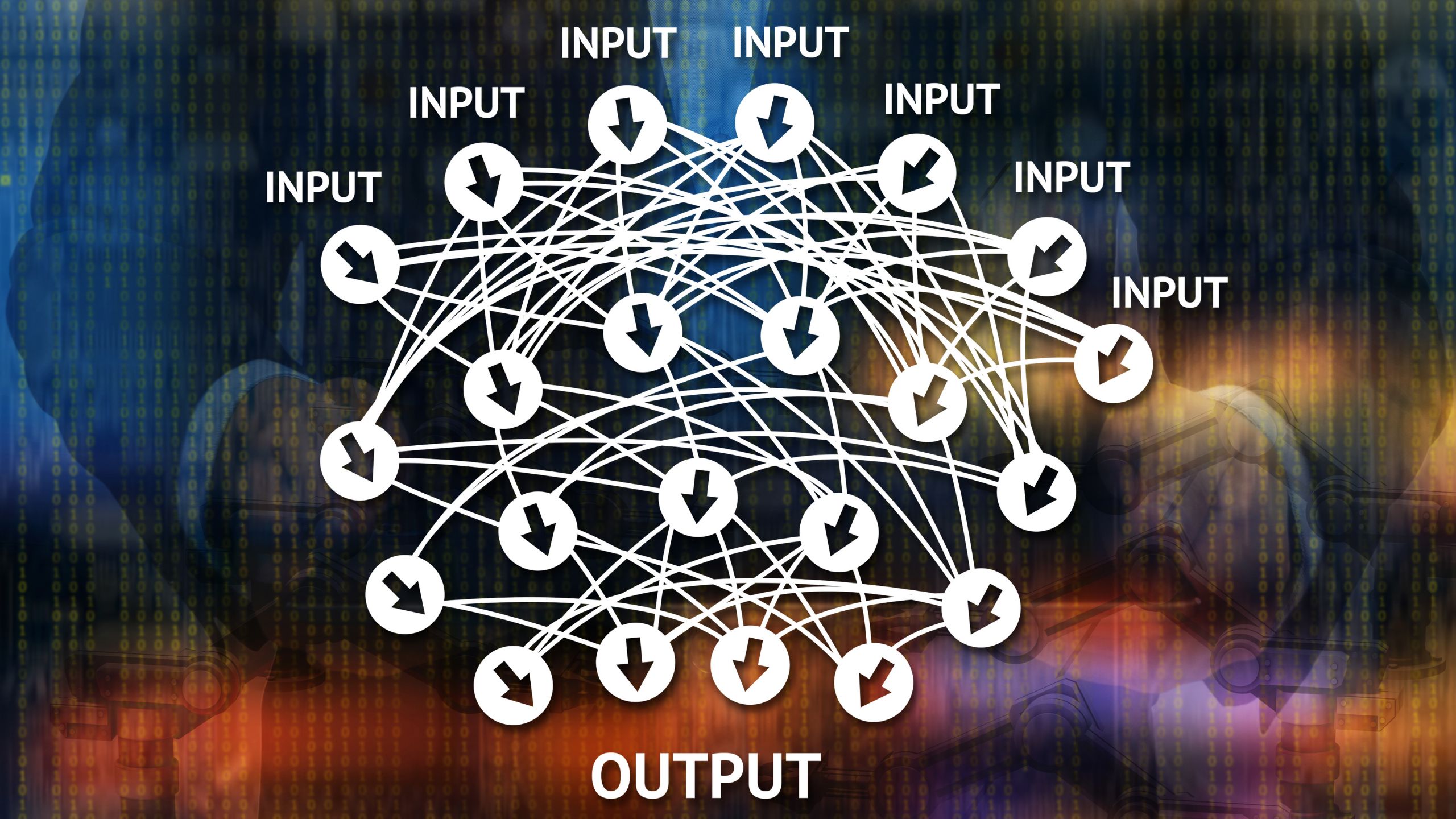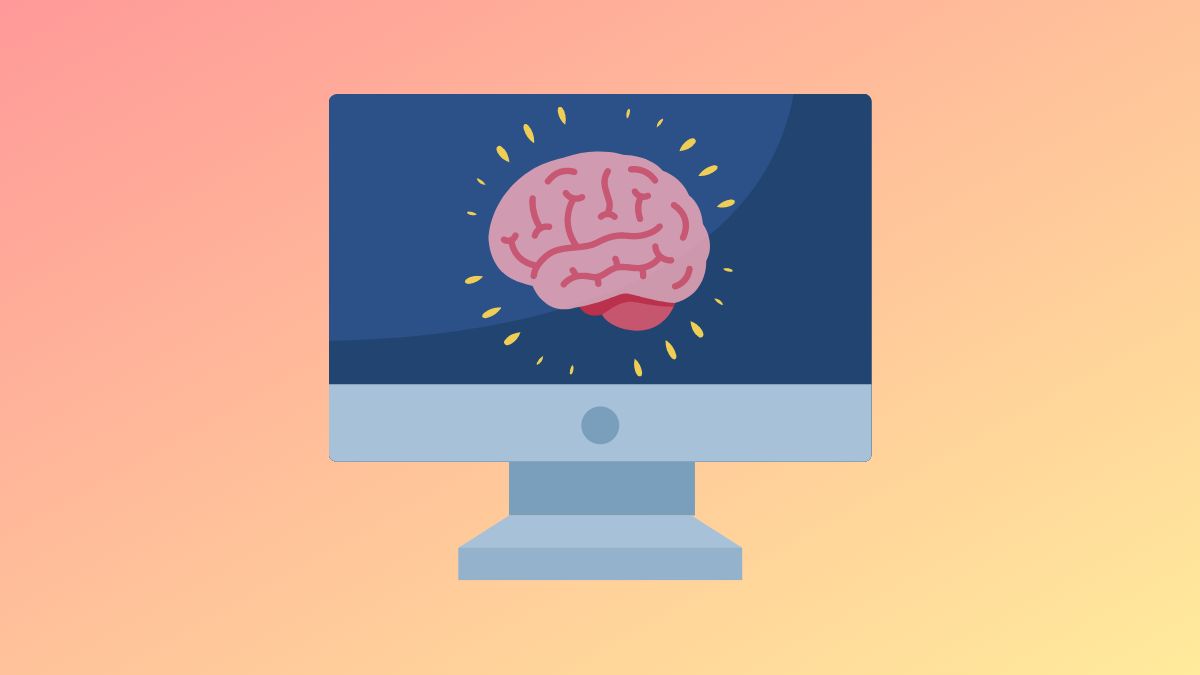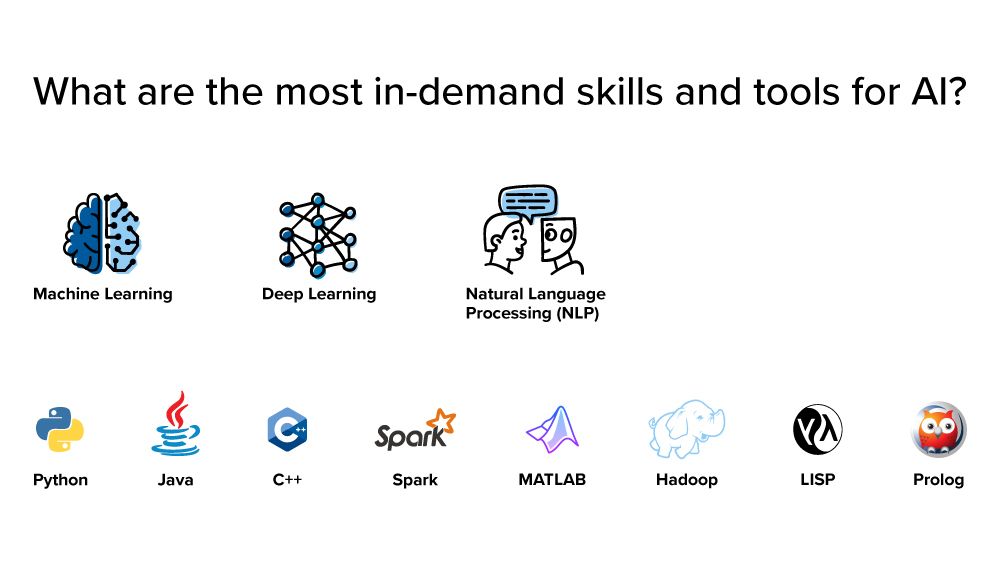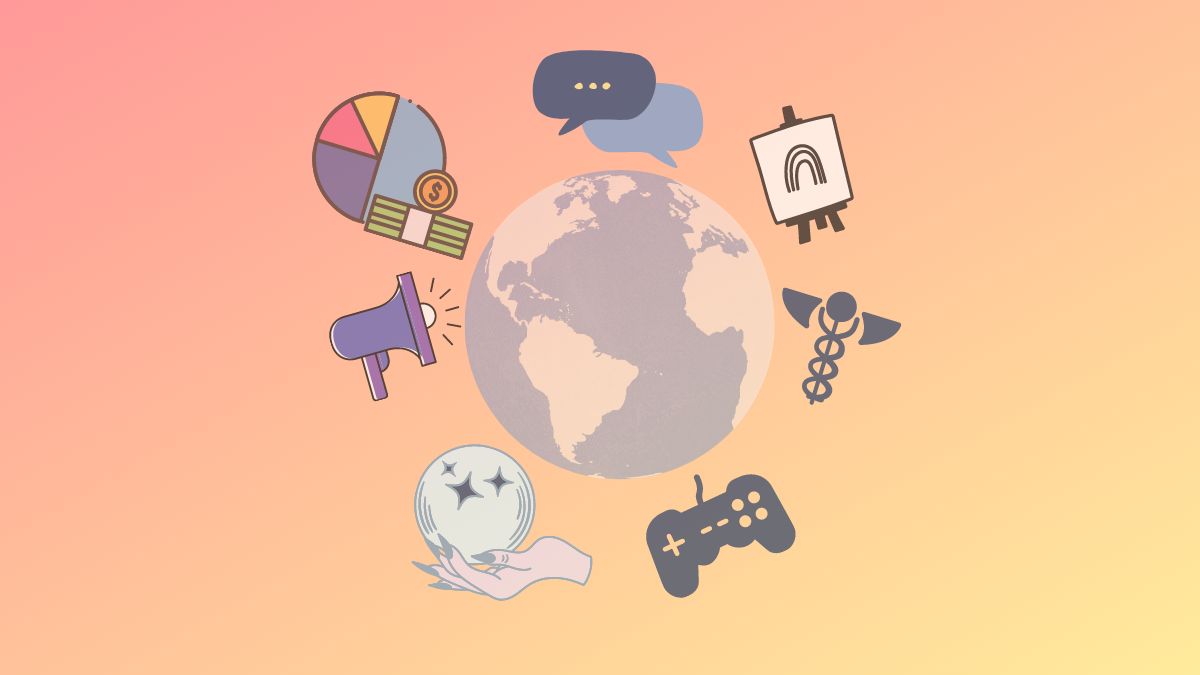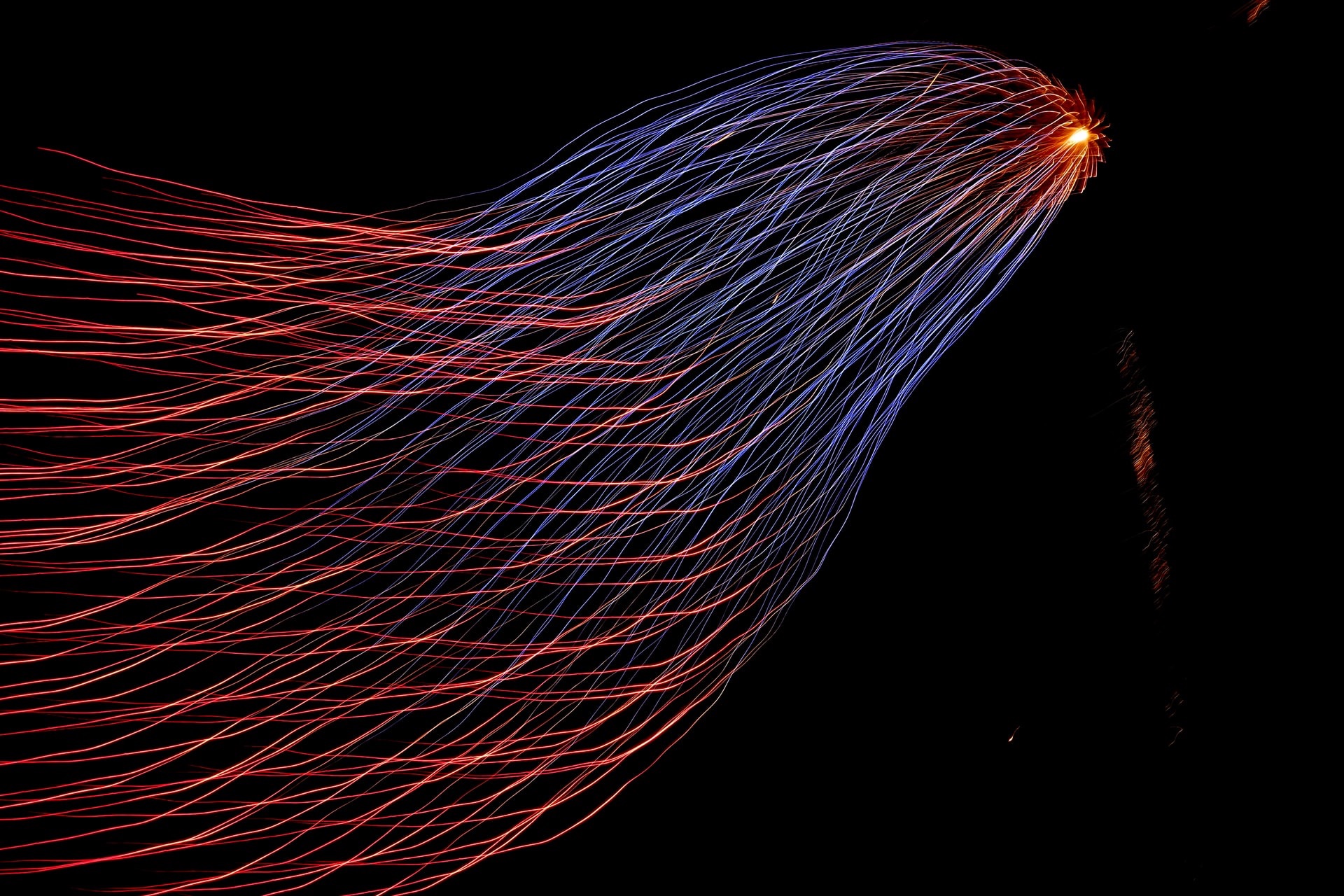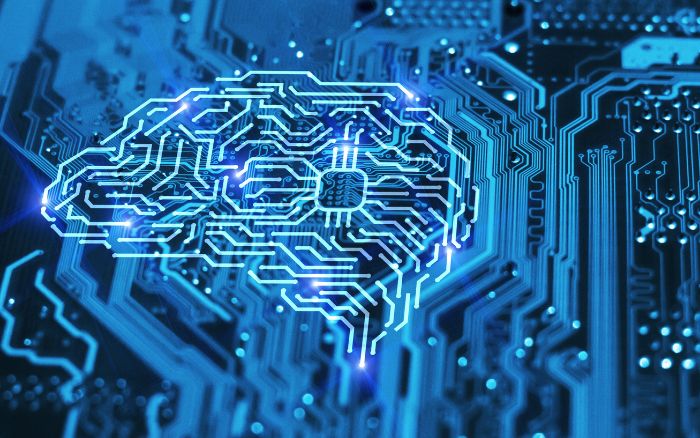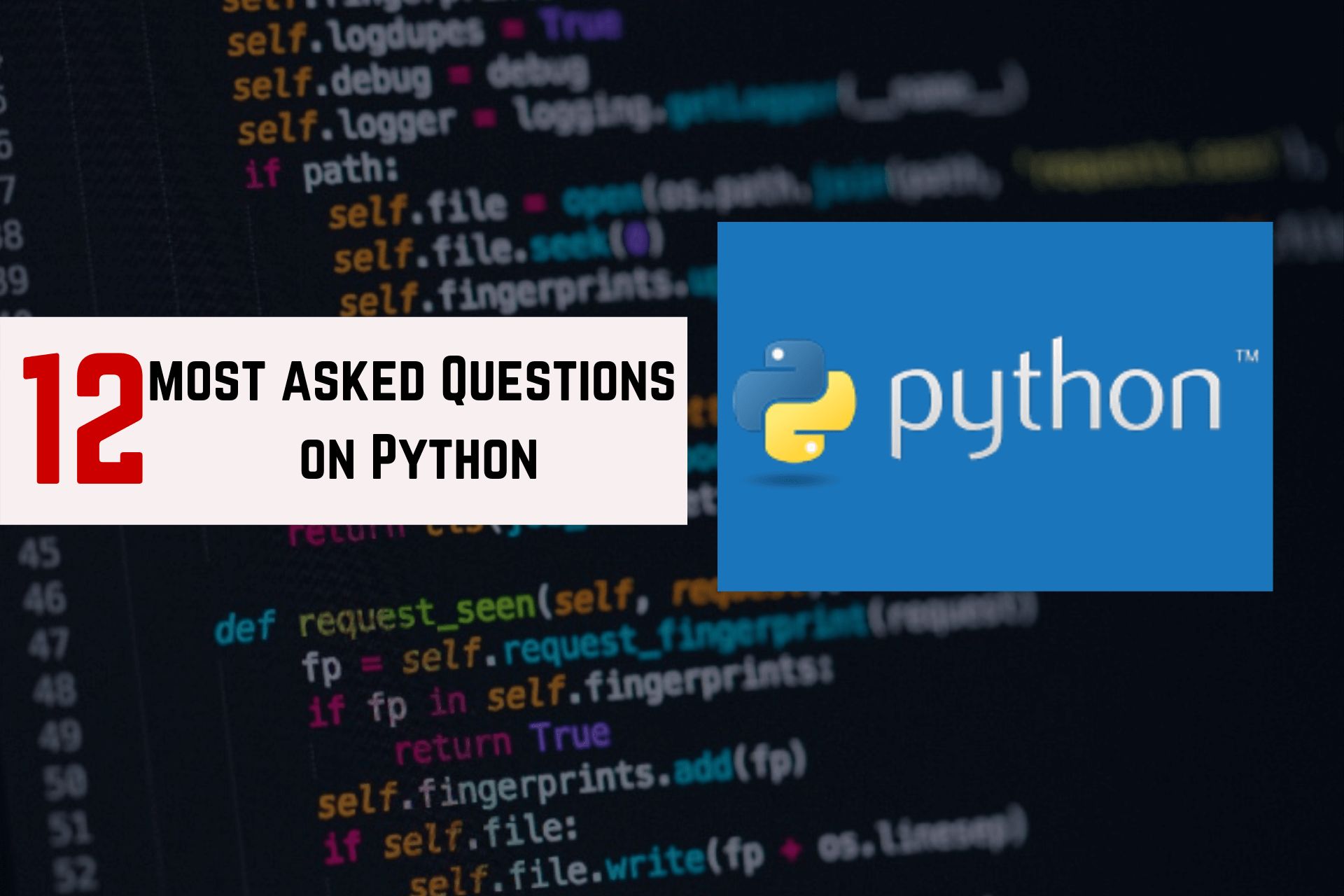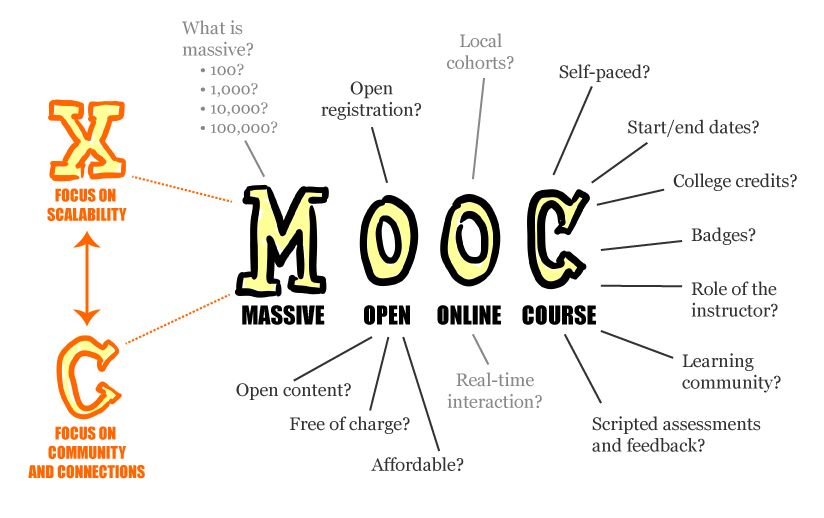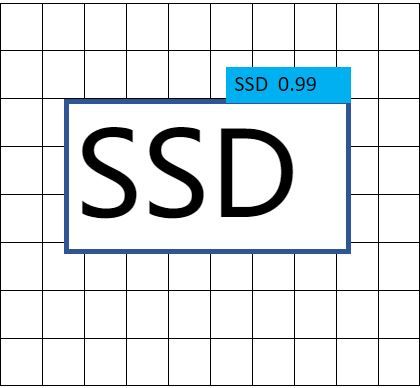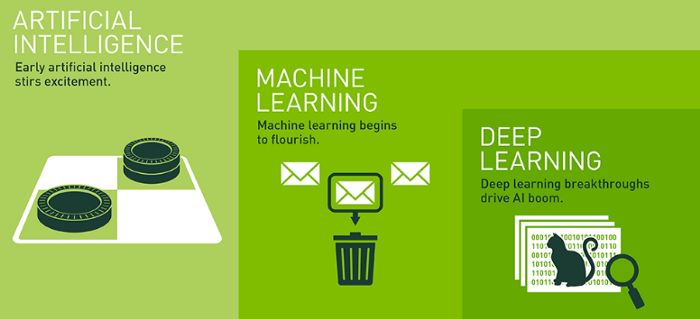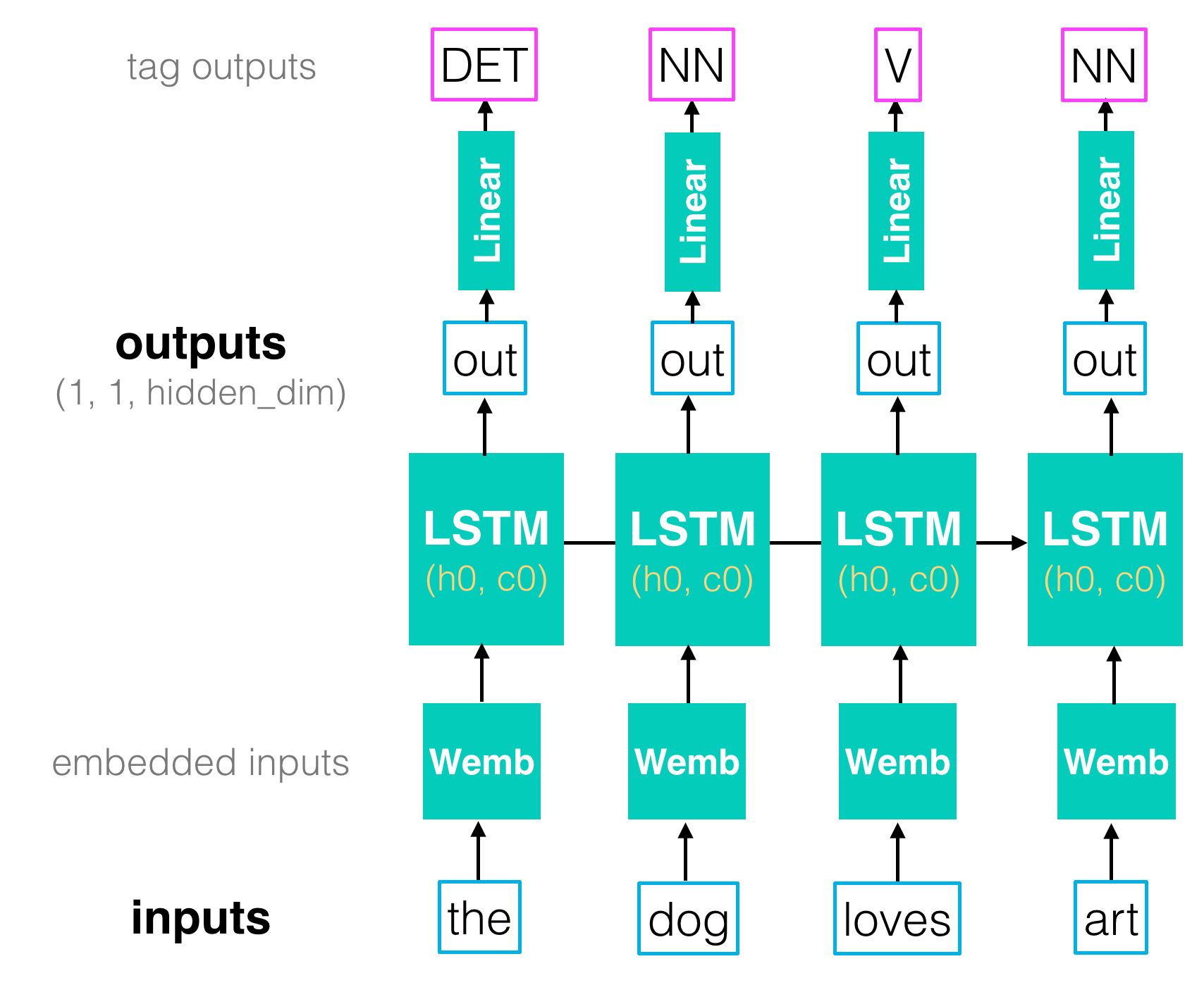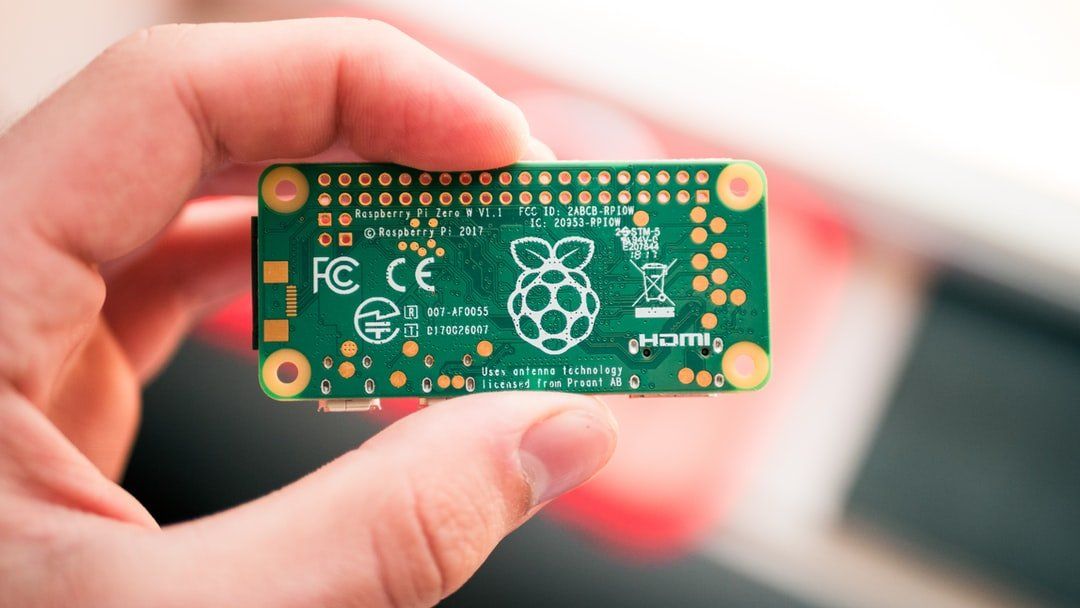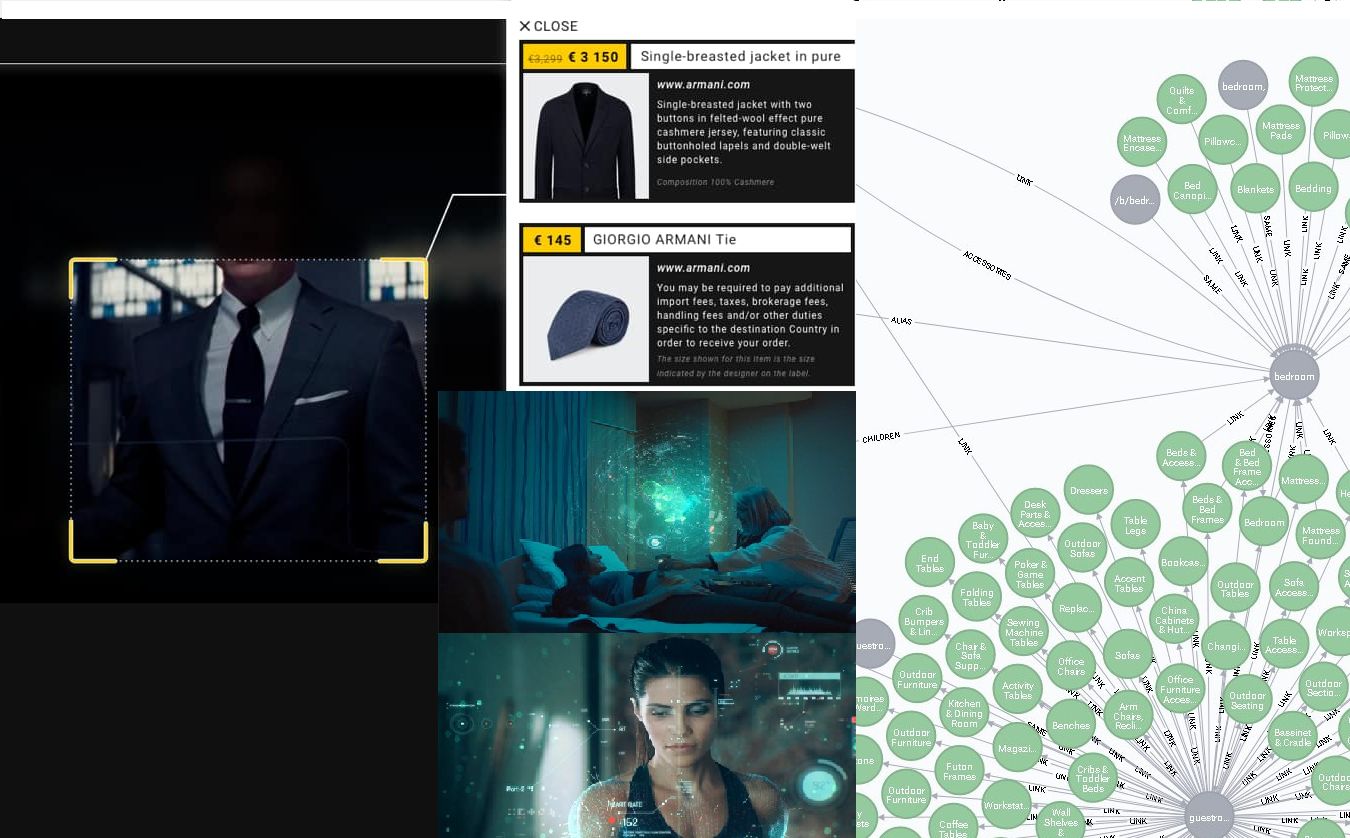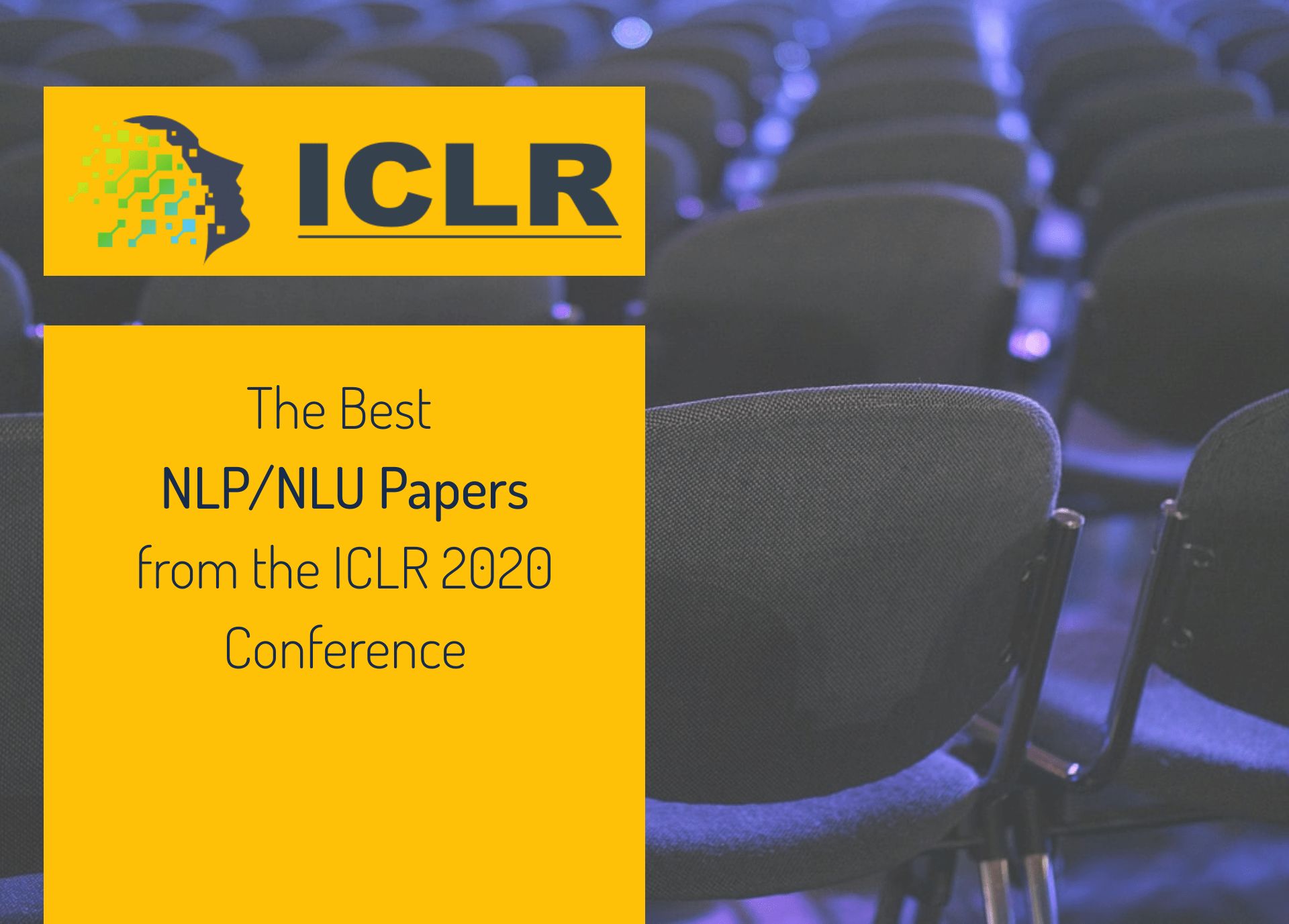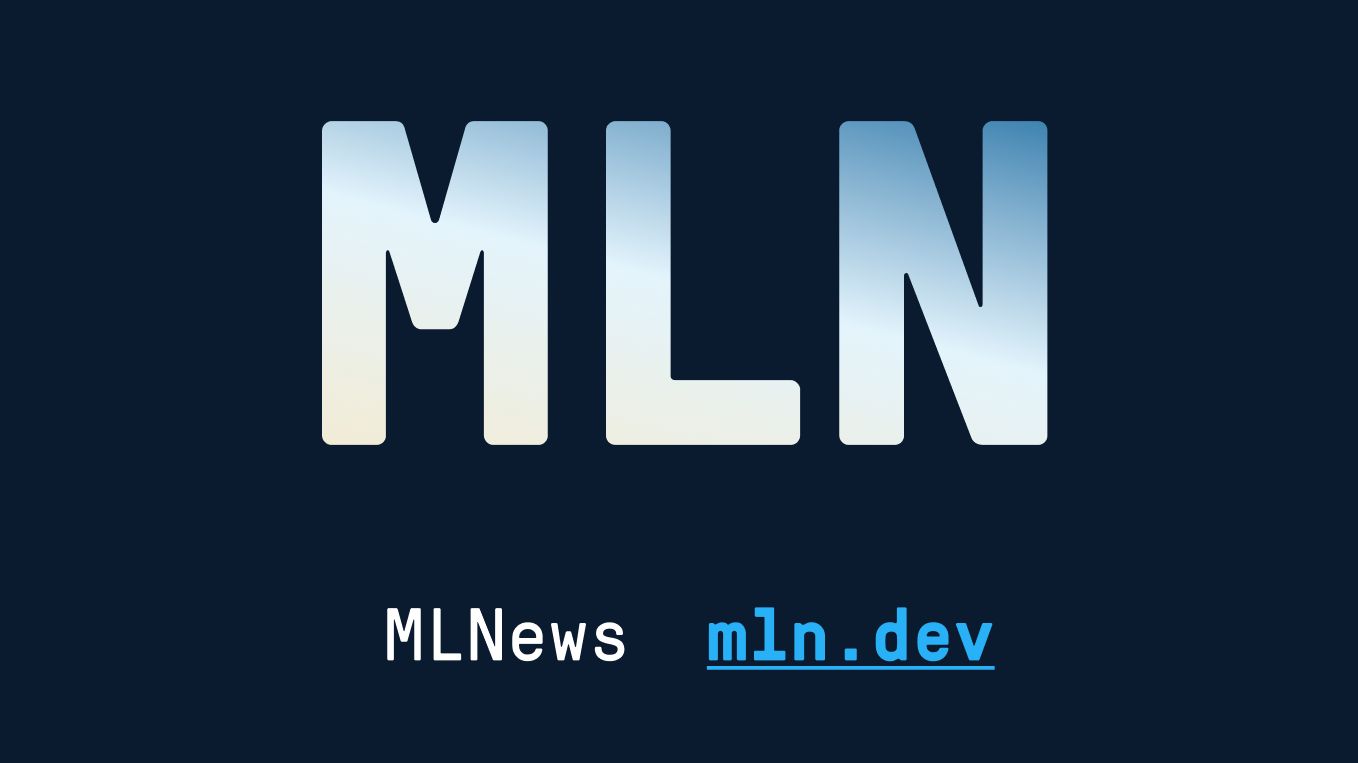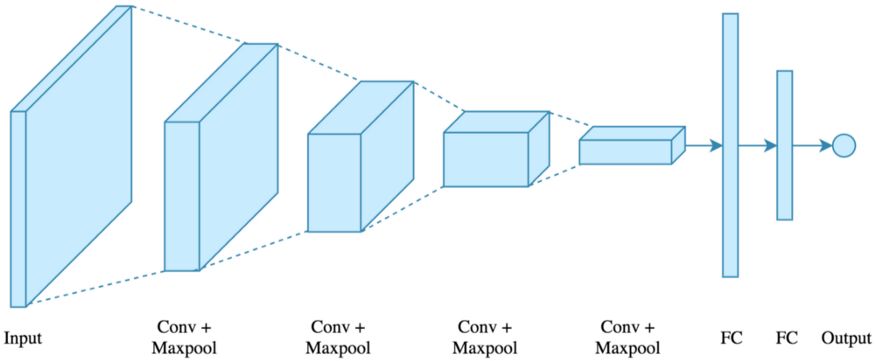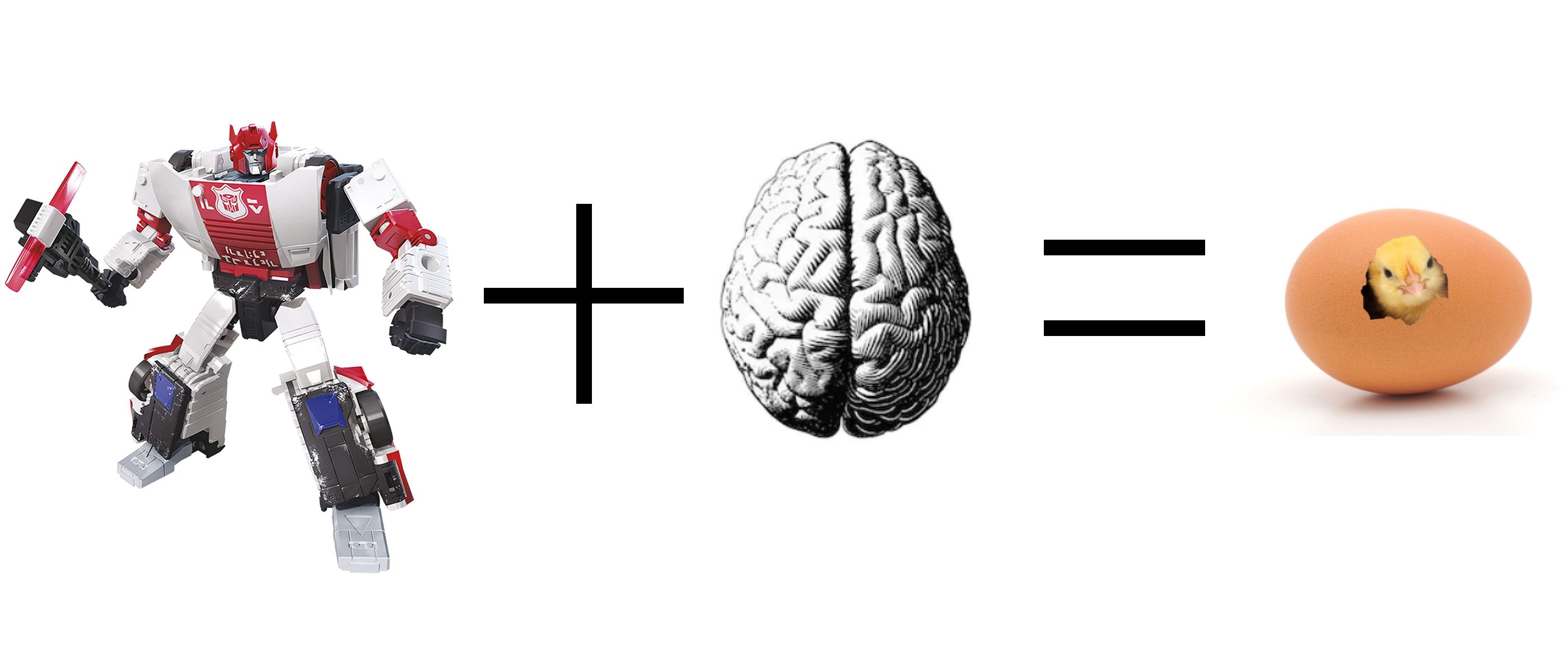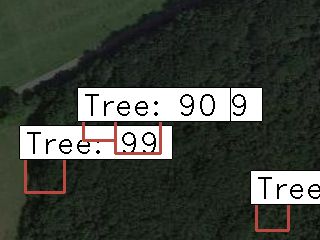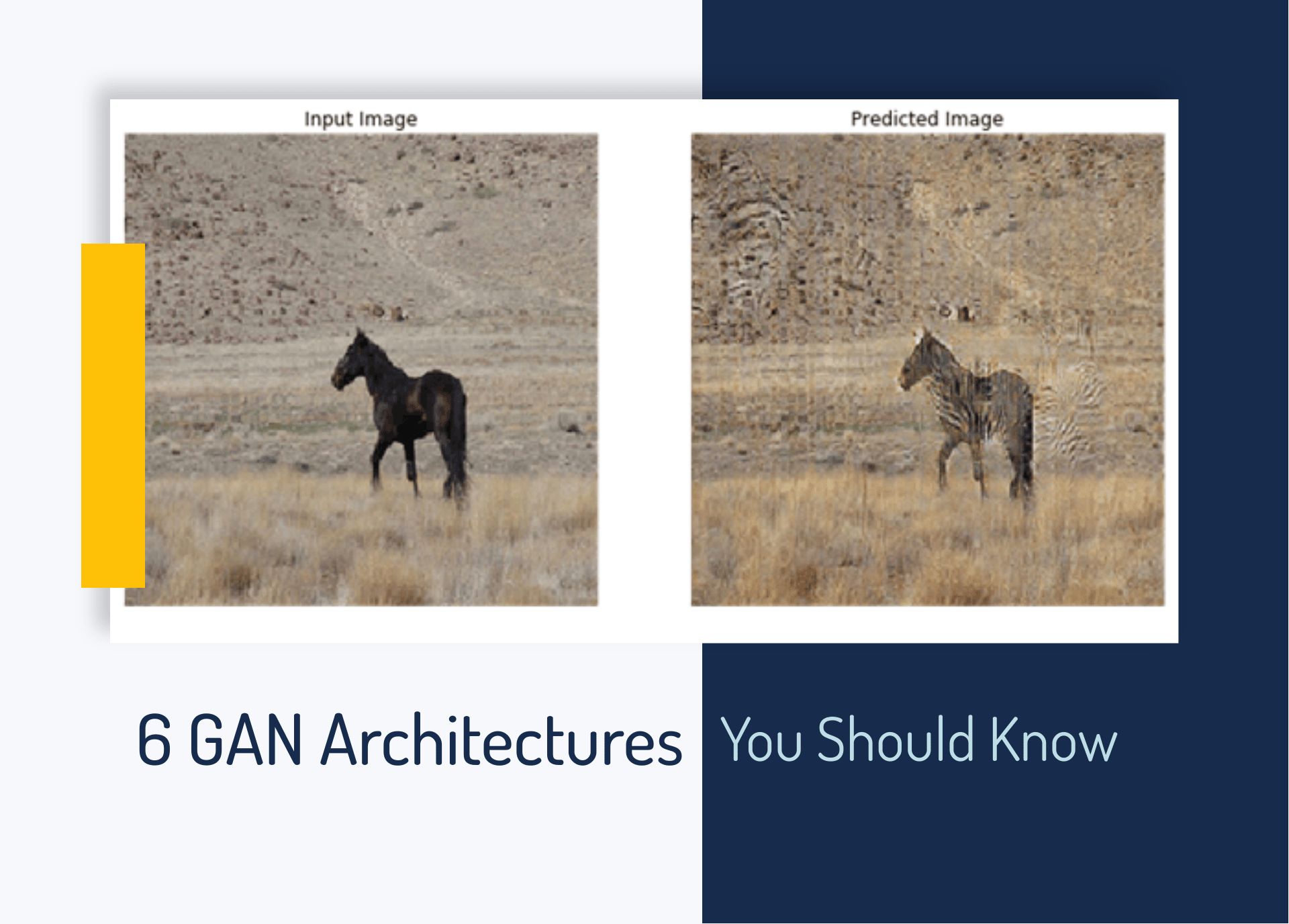
Curious about the deepfakes and self-driving cars? One must have an opinion on the algorithms mimicking the human brain.
 The development in the field of technology has enhanced over the years. With time, we get terms like Artificial Intelligence, machine learning, and deep learning in technology. We often confuse in these terms and define them similarly. But it is not a precise definition as these terms are different from each other. If you do not want to make this mistake again, then you must read out this article. Here we are going to discuss the difference in these three terms AI, ML, and Deep learning.
The development in the field of technology has enhanced over the years. With time, we get terms like Artificial Intelligence, machine learning, and deep learning in technology. We often confuse in these terms and define them similarly. But it is not a precise definition as these terms are different from each other. If you do not want to make this mistake again, then you must read out this article. Here we are going to discuss the difference in these three terms AI, ML, and Deep learning.
 In the past few years, the programming language that has got the highest fame across the globe is Python. The stardom Python has today in the IT industry is sky-high. And why not? Python has got everything that makes it the deserving candidate for the tag of- “Most Demanded Programming language on the Planet.” So, now it’s your time to do something innovative.
In the past few years, the programming language that has got the highest fame across the globe is Python. The stardom Python has today in the IT industry is sky-high. And why not? Python has got everything that makes it the deserving candidate for the tag of- “Most Demanded Programming language on the Planet.” So, now it’s your time to do something innovative.
 This article about the future of data augmentation was written entirely by GPT-J. It is published here unedited. You can try GPT-J here for free.
This article about the future of data augmentation was written entirely by GPT-J. It is published here unedited. You can try GPT-J here for free.

 A detailed list of useful artificial intelligence tools you can use for company purposes, such as business analytics, data capture, data science, ML and more
A detailed list of useful artificial intelligence tools you can use for company purposes, such as business analytics, data capture, data science, ML and more
 As per Gartner, almost 80 percent of every emerging technology will have Artificial Intelligence as the backbone by the end of 2021. Building secure software is a no mean feat. Amid the lingering cybersecurity threats and the potential challenges posed by the endpoint inadequacies, the focus is continuously shifting towards machine learning and the relevant AI implementations for strengthening the existing app and software security standards.
As per Gartner, almost 80 percent of every emerging technology will have Artificial Intelligence as the backbone by the end of 2021. Building secure software is a no mean feat. Amid the lingering cybersecurity threats and the potential challenges posed by the endpoint inadequacies, the focus is continuously shifting towards machine learning and the relevant AI implementations for strengthening the existing app and software security standards.
 While the release of GPT-3 marks a significant milestone in the development of AI, the path forward is still obscure. There are still certain limitations to the technology today. Here are six of the major limitations facing data scientists today.
While the release of GPT-3 marks a significant milestone in the development of AI, the path forward is still obscure. There are still certain limitations to the technology today. Here are six of the major limitations facing data scientists today.
 When you’re creating a chatbot, your goal should be to make one that it requires minimal or no human interference. This can be achieved by two methods.
When you’re creating a chatbot, your goal should be to make one that it requires minimal or no human interference. This can be achieved by two methods.
 There’s an astronomical difference between simply writing code and being a great developer.
There’s an astronomical difference between simply writing code and being a great developer.
 A few days ago, I presented a webinar about price predictions for cryptocurrencies. The webinar summarized some of the lessons we have learned building prediction models for crypto-assets in the IntoTheBlock platform. We have a lot of interesting IP and research coming out in this area but I wanted to summarize some key ideas that can result helpful if you are intrigued by the idea of predicting the price of crypto-assets.
A few days ago, I presented a webinar about price predictions for cryptocurrencies. The webinar summarized some of the lessons we have learned building prediction models for crypto-assets in the IntoTheBlock platform. We have a lot of interesting IP and research coming out in this area but I wanted to summarize some key ideas that can result helpful if you are intrigued by the idea of predicting the price of crypto-assets.
 For years, nobody wanted to read about AI. It was a backwater of research, solving toy problems while crashing and burning on real world challenges.
For years, nobody wanted to read about AI. It was a backwater of research, solving toy problems while crashing and burning on real world challenges.
 Contour Plot
Contour Plot
 “I don’t want a full paper, just give me a concise summary of it”. Who hasn't found themselves in this situation, at least once? Sound familiar?
“I don’t want a full paper, just give me a concise summary of it”. Who hasn't found themselves in this situation, at least once? Sound familiar?
 To estimate the trends of Artificial Intelligence (AI) 2021, we need to remember that 2018, 2019 and 2020 witnessed a multitude of platforms, applications, and tools which are based on artificial intelligence and machine learning.
To estimate the trends of Artificial Intelligence (AI) 2021, we need to remember that 2018, 2019 and 2020 witnessed a multitude of platforms, applications, and tools which are based on artificial intelligence and machine learning.
 A curated list of courses to learn data science, machine learning, and deep learning fundamentals.
A curated list of courses to learn data science, machine learning, and deep learning fundamentals.
 A complete guide to learn translations between any language pairs
A complete guide to learn translations between any language pairs
 ArtLine is based on Deep-Learning algorithms that will take your image input and transform it into a line art. I started this project as fun project but was excited to see how it turned out. The results from this model are so good that it is almost equal to the line art by an artist.
ArtLine is based on Deep-Learning algorithms that will take your image input and transform it into a line art. I started this project as fun project but was excited to see how it turned out. The results from this model are so good that it is almost equal to the line art by an artist.
 In this post, we will see how to implement the perceptron model using breast cancer data set in python.
In this post, we will see how to implement the perceptron model using breast cancer data set in python.
 An interview with Cohere's deep learning engineer Kuba Perlin and how he navigated his career into AI research.
An interview with Cohere's deep learning engineer Kuba Perlin and how he navigated his career into AI research.
 One of the trickiest situations in machine learning is when you have to deal with datasets coming from different time scales.
One of the trickiest situations in machine learning is when you have to deal with datasets coming from different time scales.
 Using EbSynth and Insta Toon to create awesome cell shaded painted videos/GIF.
Using EbSynth and Insta Toon to create awesome cell shaded painted videos/GIF.
 Most people would think I was crazy for starting 2020 as a college dropout (sorry mom!), but I wish I made this decision sooner.
Most people would think I was crazy for starting 2020 as a college dropout (sorry mom!), but I wish I made this decision sooner.
 I know.
I know.
 Pandas is a powerful and popular library for working with data in Python. It provides tools for handling and manipulating large and complex datasets.
Pandas is a powerful and popular library for working with data in Python. It provides tools for handling and manipulating large and complex datasets.
 An image labeling or annotation tool is used to label the images for bounding box object detection and segmentation. It is the process of highlighting the images by humans. They have to be readable for machines. With the help of the image labeling tools, the objects in the image could be labeled for a specific purpose. The process of object labeling makes it easy for people to understand what is in the image. The labeling tool helps the people to mark the items in an image. There are several image labeling tools for object detection, and some of them use varied techniques for detection of the object, like a semantic, bounding box, key-point, cuboid, semantic and many more. In this article, we will talk about image labeling and the best image labeling tools.
An image labeling or annotation tool is used to label the images for bounding box object detection and segmentation. It is the process of highlighting the images by humans. They have to be readable for machines. With the help of the image labeling tools, the objects in the image could be labeled for a specific purpose. The process of object labeling makes it easy for people to understand what is in the image. The labeling tool helps the people to mark the items in an image. There are several image labeling tools for object detection, and some of them use varied techniques for detection of the object, like a semantic, bounding box, key-point, cuboid, semantic and many more. In this article, we will talk about image labeling and the best image labeling tools.
 You shall have no other programmers but me.
You shall have no other programmers but me.
 A project that added Additive White Gaussian Noise to a sinusoidal signal before training machine learning networks to denoise it effectively as a challenge.
A project that added Additive White Gaussian Noise to a sinusoidal signal before training machine learning networks to denoise it effectively as a challenge.
 We are slowly but surely moving towards a world where autonomous drones will play a major role. In this article, I will show you what stopes them today.
We are slowly but surely moving towards a world where autonomous drones will play a major role. In this article, I will show you what stopes them today.
 Former New York Times foreign correspondent turns to deep tech.
Former New York Times foreign correspondent turns to deep tech.
 “I used to brag about talks I gave; now I brag about talks I turned down.”
“I used to brag about talks I gave; now I brag about talks I turned down.”
 Create a deep learning framework from scratch!
Create a deep learning framework from scratch!
 There are still areas where AI lacks and causes problems and frustration to end-users, and these areas pose a great challenge for researchers right now.
There are still areas where AI lacks and causes problems and frustration to end-users, and these areas pose a great challenge for researchers right now.
 Why are GPT-3 and all the other transformer models so exciting? Let's find out!
Why are GPT-3 and all the other transformer models so exciting? Let's find out!
 As an aspiring data scientist, the best way for you to increase your skill level is by practicing. And what better way is there for practicing your technical skills than making projects.
As an aspiring data scientist, the best way for you to increase your skill level is by practicing. And what better way is there for practicing your technical skills than making projects.
 COVID-19 has impacted every other industry and has made people adopt newer norms. The traditional translation industry is no different. Several disruptions have been introduced to keep things moving, thanks to Big data and machine translation technologies that have enabled the world to do business as usual.
COVID-19 has impacted every other industry and has made people adopt newer norms. The traditional translation industry is no different. Several disruptions have been introduced to keep things moving, thanks to Big data and machine translation technologies that have enabled the world to do business as usual.
 Large language models like ChatGPT are making it easier to manage data. Akkio has come up with an LLM-based tool to manage tabular data using conversational AI.
Large language models like ChatGPT are making it easier to manage data. Akkio has come up with an LLM-based tool to manage tabular data using conversational AI.
 This article summarizes the problem statement, solution, and other key technical components of the paper: End-to-End Neural Entity Linking in JP Morgan Chase
This article summarizes the problem statement, solution, and other key technical components of the paper: End-to-End Neural Entity Linking in JP Morgan Chase
 Differences between SLU (Spoken Language Understanding) and NLU (Natural Language Understanding). Top FOSS and paid engines and their approach to SLU.
Differences between SLU (Spoken Language Understanding) and NLU (Natural Language Understanding). Top FOSS and paid engines and their approach to SLU.
 We're launching Model Playground, a model-building product where you can train AI models without writing any code yourself. Still, with you in complete control.
We're launching Model Playground, a model-building product where you can train AI models without writing any code yourself. Still, with you in complete control.
 Welcome to part four of Learning AI if You Suck at Math. If you missed parts 1, 2, 3, 5, 6 and 7 be sure to check them out.
Welcome to part four of Learning AI if You Suck at Math. If you missed parts 1, 2, 3, 5, 6 and 7 be sure to check them out.
 Were you ever annoyed when you had to pull a massive dataset (versioned using DVC) before training your model?
Were you ever annoyed when you had to pull a massive dataset (versioned using DVC) before training your model?
 In this post, I’ll show how you can reduce image sizes by an additional 20–50% with a single line of code.
In this post, I’ll show how you can reduce image sizes by an additional 20–50% with a single line of code.
 There are a lot of Machine Learning courses, and we are pretty good at modeling and improving our accuracy or other metrics.
There are a lot of Machine Learning courses, and we are pretty good at modeling and improving our accuracy or other metrics.
 We know that the whole world is fascinated by the tools that are using Machine learning and deep learning algorithms and they are fun to use.
We know that the whole world is fascinated by the tools that are using Machine learning and deep learning algorithms and they are fun to use.
 Machine learning (ML) is the process which enables a computer to perform something that it has not been explicitly told to do. Hence, ML assumes the central role in making sentient machines a reality. With the launch of Sophia, an AI robot developed by Hanson robotics, we wonder how close we are to be outclassed by these smart fellows.
Machine learning (ML) is the process which enables a computer to perform something that it has not been explicitly told to do. Hence, ML assumes the central role in making sentient machines a reality. With the launch of Sophia, an AI robot developed by Hanson robotics, we wonder how close we are to be outclassed by these smart fellows.
 Rich Harang explains why you should use deep learning.
Rich Harang explains why you should use deep learning.
 In the current big data regime, it is hard to fit all the data into a single CPU.
In the current big data regime, it is hard to fit all the data into a single CPU.
 Reinforcement learning is the fastest growing branches of machine learning. Embark your RL journey by getting a soft introduction to reinforcement learning now.
Reinforcement learning is the fastest growing branches of machine learning. Embark your RL journey by getting a soft introduction to reinforcement learning now.
 Photo from Pinterest Here -> this screenshot comes from a Martin Episode that you can watch here and get a good laugh 😂
Photo from Pinterest Here -> this screenshot comes from a Martin Episode that you can watch here and get a good laugh 😂
 A detailed plan for going from not being able to write code to being a deep learning expert. Advice based on personal experience.
A detailed plan for going from not being able to write code to being a deep learning expert. Advice based on personal experience.
 I know.
I know.
 Want to get your hands dirty with Machine Learning / Deep Learning, but have a Java background and not sure where to start? Then read on! This article is about using an existing Java skillset and ramp-up your journey to start building deep learning models.
Want to get your hands dirty with Machine Learning / Deep Learning, but have a Java background and not sure where to start? Then read on! This article is about using an existing Java skillset and ramp-up your journey to start building deep learning models.
 Access to training data is one of the largest blockers for many machine learning projects. Luckily, for various different projects, we can use data augmentation to increase the size of our training data many times over.
Access to training data is one of the largest blockers for many machine learning projects. Luckily, for various different projects, we can use data augmentation to increase the size of our training data many times over.
 The workflow for building machine learning models often ends at the evaluation stage: you have achieved an acceptable accuracy, and “ta-da! Mission Accomplished.”
The workflow for building machine learning models often ends at the evaluation stage: you have achieved an acceptable accuracy, and “ta-da! Mission Accomplished.”
 Nowadays, we are seeing a new wave and great advancements in different technologies. Things like Deep Learning, Computer Vision, and Artificial Intelligence are improving every single day. And Researchers and scientists are having amazing use-cases with these technologies which can change the direction of our world.
Nowadays, we are seeing a new wave and great advancements in different technologies. Things like Deep Learning, Computer Vision, and Artificial Intelligence are improving every single day. And Researchers and scientists are having amazing use-cases with these technologies which can change the direction of our world.
 Multiple models trained on your data perform surprisingly poorly, despite having decent metrics on the validation set. The code seems fine, so you decide to take a closer look at your training data. You check a random sample - the label is wrong. So is the next. Your stomach sinks and you start looking through your data in batches*. Thirty minutes later, you realize that x% of your data is incorrect.
Multiple models trained on your data perform surprisingly poorly, despite having decent metrics on the validation set. The code seems fine, so you decide to take a closer look at your training data. You check a random sample - the label is wrong. So is the next. Your stomach sinks and you start looking through your data in batches*. Thirty minutes later, you realize that x% of your data is incorrect.
 Here's how you can use cognitive computing to automate media & entertainment workflows and stramline video production.
Here's how you can use cognitive computing to automate media & entertainment workflows and stramline video production.
 Learn how tensorflow or pytorch implement optimization algorithms by using numpy and create beautiful animations using matplotlib
Learn how tensorflow or pytorch implement optimization algorithms by using numpy and create beautiful animations using matplotlib
 Welcome to part five of Learning AI if You Suck at Math. If you missed parts 1, 2, 3, 4, 6, and 7 be sure to check them out!
Welcome to part five of Learning AI if You Suck at Math. If you missed parts 1, 2, 3, 4, 6, and 7 be sure to check them out!
 Artificial Intelligence and the fourth industrial revolution has made some considerable progress over the last couple of years. Most of this current progress that is usable has been developed for industry and business purposes, as you’ll see in coming posts. Research institutes and dedicated, specialised companies are working toward the ultimate goal of AI (cracking artificial general intelligence), developing open platforms and the looking into the ethics that follow suit. There are also a good handful of companies working on AI products for consumers, which is what we’ll be kicking this series of posts off with.
Artificial Intelligence and the fourth industrial revolution has made some considerable progress over the last couple of years. Most of this current progress that is usable has been developed for industry and business purposes, as you’ll see in coming posts. Research institutes and dedicated, specialised companies are working toward the ultimate goal of AI (cracking artificial general intelligence), developing open platforms and the looking into the ethics that follow suit. There are also a good handful of companies working on AI products for consumers, which is what we’ll be kicking this series of posts off with.
 Facial recognition, is one of the largest areas of research within computer vision. This article will introduce 5 face recognition papers for data scientists.
Facial recognition, is one of the largest areas of research within computer vision. This article will introduce 5 face recognition papers for data scientists.
 In this article, I will share my thoughts on why it's better and safer to bring the new AI tech into the hands of business rather than release it into the wild.
In this article, I will share my thoughts on why it's better and safer to bring the new AI tech into the hands of business rather than release it into the wild.
 If you are a beginner and just started machine learning or even an intermediate level programmer, you might have been stuck on how do you solve this problem. Where do you start? and where do you go from here?
If you are a beginner and just started machine learning or even an intermediate level programmer, you might have been stuck on how do you solve this problem. Where do you start? and where do you go from here?
 Getting started with embeddings using open-source tools.
Getting started with embeddings using open-source tools.
 DeepMind may allude to two things: the innovation behind Google’s man-made reasoning (AI) venture, and the organization that is liable for it. The organization DeepMind is an auxiliary of Alphabet, the parent organization of Google.
DeepMind may allude to two things: the innovation behind Google’s man-made reasoning (AI) venture, and the organization that is liable for it. The organization DeepMind is an auxiliary of Alphabet, the parent organization of Google.
 The online data science community is supportive and collaborative. One of the ways you can join the community is to find machine learning and AI Slack groups.
The online data science community is supportive and collaborative. One of the ways you can join the community is to find machine learning and AI Slack groups.
 Singapore is home to some of the best schools in the field of Computer Science, specifically Artificial Intelligence. The cutting edge research going on there is unparalleled. Colleges like Nanyang Technological University (NTU) and National University of Singapore (NUS) have a great reputation all over the world for their CS programs.
Singapore is home to some of the best schools in the field of Computer Science, specifically Artificial Intelligence. The cutting edge research going on there is unparalleled. Colleges like Nanyang Technological University (NTU) and National University of Singapore (NUS) have a great reputation all over the world for their CS programs.
 Deep learning models are capable of performing on par with, if not exceeding, human levels, at a variety of different tasks and objectives.
Deep learning models are capable of performing on par with, if not exceeding, human levels, at a variety of different tasks and objectives.
 Deep Learning gets a ton of traction from technology enthusiasts. But can it match the effectiveness standards that the public hold it to?
Deep Learning gets a ton of traction from technology enthusiasts. But can it match the effectiveness standards that the public hold it to?
 How to carry out small object detection with Computer Vision - An example of finding lost people in a forest.
How to carry out small object detection with Computer Vision - An example of finding lost people in a forest.
 Using PyTorch, FastAI and the CIFAR-10 image dataset
Using PyTorch, FastAI and the CIFAR-10 image dataset
 In 2019, more than 627 million online records were comprised due to hacking and other types of cyber attacks. This is a pretty staggering number to anyone who has made an online transaction, but the amount of attacks that were stopped is much higher, so it’s worth some optimism. As COVID-19 has pushed many companies into the remote work world, online transactions and records are growing exponentially, and most experts believe that remote work will continue to be very popular even after stay-at-home orders get lifted and life goes back to some form of normal.
In 2019, more than 627 million online records were comprised due to hacking and other types of cyber attacks. This is a pretty staggering number to anyone who has made an online transaction, but the amount of attacks that were stopped is much higher, so it’s worth some optimism. As COVID-19 has pushed many companies into the remote work world, online transactions and records are growing exponentially, and most experts believe that remote work will continue to be very popular even after stay-at-home orders get lifted and life goes back to some form of normal.
 Sponsor: Scraper API's 5 Tips for Web Scraping
Sponsor: Scraper API's 5 Tips for Web Scraping
 Learn how to deploy deep learning models with Model Server.
Learn how to deploy deep learning models with Model Server.
 Closing b2b deals is difficult. People are not buying aggressive selling techniques. Existing sales softwares aren't helping. New tech can help.
Closing b2b deals is difficult. People are not buying aggressive selling techniques. Existing sales softwares aren't helping. New tech can help.
 Karate Club is an unsupervised machine learning extension library for the NetworkX Python package. See the documentation here.
Karate Club is an unsupervised machine learning extension library for the NetworkX Python package. See the documentation here.
 Introduction
Introduction
 Major companies using AI and machine learning now use federated learning – a form of machine learning that trains algorithms on a distributed set of devices.
Major companies using AI and machine learning now use federated learning – a form of machine learning that trains algorithms on a distributed set of devices.
 A big question for Machine Learning and Deep Learning apps developers is whether or not to use a computer with a GPU, after all, GPUs are still very expensive. To get an idea, see the price of a typical GPU for processing AI in Brazil costs between US $ 1,000.00 and US $ 7,000.00 (or more).
A big question for Machine Learning and Deep Learning apps developers is whether or not to use a computer with a GPU, after all, GPUs are still very expensive. To get an idea, see the price of a typical GPU for processing AI in Brazil costs between US $ 1,000.00 and US $ 7,000.00 (or more).
 Retraining Machine Learning Model, Model Drift, Different ways to identify model drift, Performance Degradation
Retraining Machine Learning Model, Model Drift, Different ways to identify model drift, Performance Degradation
 People express a lot of fear when it comes to AI. Some worry AI will grow superhuman and kill us all. Others are concerned that AI lead automation will displace over 100 million workers and devastate the economy. Honestly, either may happen because the simple truth of AI is that when machines learn, humans lose control.
People express a lot of fear when it comes to AI. Some worry AI will grow superhuman and kill us all. Others are concerned that AI lead automation will displace over 100 million workers and devastate the economy. Honestly, either may happen because the simple truth of AI is that when machines learn, humans lose control.
 PyTorch Geometric Temporal is a deep learning library for neural spatiotemporal signal processing.
PyTorch Geometric Temporal is a deep learning library for neural spatiotemporal signal processing.
 Introduction
Introduction
 Whether you’re a beginner looking for introductory articles or an intermediate looking for datasets or papers about new AI models, this list of machine learning resources has something for everyone interested in or working in data science. In this article, we will introduce guides, papers, tools and datasets for both computer vision and natural language processing.
Whether you’re a beginner looking for introductory articles or an intermediate looking for datasets or papers about new AI models, this list of machine learning resources has something for everyone interested in or working in data science. In this article, we will introduce guides, papers, tools and datasets for both computer vision and natural language processing.
 Thinking of Machine Learning, the first frameworks that come to mind are Tensorflow and PyTorch, which are currently the state-of-the-art frameworks if you want to work with Deep Neural Networks. Technology is changing rapidly and more flexibility is needed, so Google researchers are developing a new high performance framework for the open source community: Flax.
Thinking of Machine Learning, the first frameworks that come to mind are Tensorflow and PyTorch, which are currently the state-of-the-art frameworks if you want to work with Deep Neural Networks. Technology is changing rapidly and more flexibility is needed, so Google researchers are developing a new high performance framework for the open source community: Flax.
 I built a simple Neural Network using Python that outputs a target number given a specific input number.
I built a simple Neural Network using Python that outputs a target number given a specific input number.
 Introduction
Introduction
 introduction to computer vision technologies, applications, use cases and key models.
introduction to computer vision technologies, applications, use cases and key models.
 How to use a Convolutional Neural Network to suggest visually similar products, just like Amazon or Netflix use to keep you coming back for more.
How to use a Convolutional Neural Network to suggest visually similar products, just like Amazon or Netflix use to keep you coming back for more.
 These days, machine learning and computer vision are all the craze. We’ve all seen the news about self-driving cars and facial recognition and probably imagined how cool it’d be to build our own computer vision models. However, it’s not always easy to break into the field, especially without a strong math background. Libraries like PyTorch and TensorFlow can be tedious to learn if all you want to do is experiment with something small.
These days, machine learning and computer vision are all the craze. We’ve all seen the news about self-driving cars and facial recognition and probably imagined how cool it’d be to build our own computer vision models. However, it’s not always easy to break into the field, especially without a strong math background. Libraries like PyTorch and TensorFlow can be tedious to learn if all you want to do is experiment with something small.
 While improvements in AI and Deep Learning move forward at an ever increasingly rapid rate, people have started to ask questions. Questions about jobs being made obsolete, questions about the inherent biases programmed into the neural networks, questions about whether or not AI will eventually consider humans as dead-weight and unnecessary to achieve the goals they've been tasked programmed with.
While improvements in AI and Deep Learning move forward at an ever increasingly rapid rate, people have started to ask questions. Questions about jobs being made obsolete, questions about the inherent biases programmed into the neural networks, questions about whether or not AI will eventually consider humans as dead-weight and unnecessary to achieve the goals they've been tasked programmed with.

 The relationship between Bitcoin and Gold is one of the dynamics that seems to constantly capture the minds of financial analysts. Recently, there have been a series of new articles claiming an increasing “correlation” between Bitcoin and Gold and the phenomenon seems to be constantly debated in financial media outlets like CNBC or Bloomberg.
The relationship between Bitcoin and Gold is one of the dynamics that seems to constantly capture the minds of financial analysts. Recently, there have been a series of new articles claiming an increasing “correlation” between Bitcoin and Gold and the phenomenon seems to be constantly debated in financial media outlets like CNBC or Bloomberg.
 Tree-based models like Random Forest and XGBoost have become very popular in solving tabular(structured) data problems and gained a lot of tractions in Kaggle competitions lately. It has its very deserving reasons. However, in this article, I want to introduce a different approach from fast.ai’s Tabular module leveraging.
Tree-based models like Random Forest and XGBoost have become very popular in solving tabular(structured) data problems and gained a lot of tractions in Kaggle competitions lately. It has its very deserving reasons. However, in this article, I want to introduce a different approach from fast.ai’s Tabular module leveraging.
 I often hear people talking about neural networks as something as a black-box that you don’t understand what it does or what they mean. Actually many people can’t understand what they mean by that. If you understand how back-propagation works, then how is it a black-box?
I often hear people talking about neural networks as something as a black-box that you don’t understand what it does or what they mean. Actually many people can’t understand what they mean by that. If you understand how back-propagation works, then how is it a black-box?
 Artificial intelligence is quickly becoming a reality, but how does it affect our society. Is it something we should fear or embrace? Read to learn more.
Artificial intelligence is quickly becoming a reality, but how does it affect our society. Is it something we should fear or embrace? Read to learn more.
 Learn more about OpenCV, how you can use it to identify and track people in real-time, and what challenges you can meet.
Learn more about OpenCV, how you can use it to identify and track people in real-time, and what challenges you can meet.
 The world’s most influential companies and technologies are influenced by the efficiency of Artificial intelligence and similar technologies. Whether it is Facebook or Amazon, Google or Microsoft, all firms are harnessing AI techniques and algorithms to introduce high-level performance and streamlined operations.
The world’s most influential companies and technologies are influenced by the efficiency of Artificial intelligence and similar technologies. Whether it is Facebook or Amazon, Google or Microsoft, all firms are harnessing AI techniques and algorithms to introduce high-level performance and streamlined operations.
 In this article, we will take a look at each one of the machine learning tools offered by AWS and understand the type of problems they try to solve for their customers.
In this article, we will take a look at each one of the machine learning tools offered by AWS and understand the type of problems they try to solve for their customers.
 There are many types of image annotations for computer vision out there, and each one of these annotation techniques has different applications.
There are many types of image annotations for computer vision out there, and each one of these annotation techniques has different applications.
 This article is about putting all the popular pre-training tasks used in various language modelling tasks at a glance.
This article is about putting all the popular pre-training tasks used in various language modelling tasks at a glance.
 Anyone watched Blade Running 2049 must remember ‘Joi’, the pretty and sophisticated holographic projection of an artificial human. She speaks to you, helps you with house affairs, tells jokes to you, keeps you accompanied, and some more… just like a real human. She even has her own memory with you and developed character over time. Except, ‘she’ is not human. She is just a super complicated ‘modeling’ of a real human that can speak, act and react like one. Yet still, quite some people secretly wish that they could also have their own ‘Joi’. Well, she might not be as far away as you think. Enter NEON, Samsung’s new artificial human.
Anyone watched Blade Running 2049 must remember ‘Joi’, the pretty and sophisticated holographic projection of an artificial human. She speaks to you, helps you with house affairs, tells jokes to you, keeps you accompanied, and some more… just like a real human. She even has her own memory with you and developed character over time. Except, ‘she’ is not human. She is just a super complicated ‘modeling’ of a real human that can speak, act and react like one. Yet still, quite some people secretly wish that they could also have their own ‘Joi’. Well, she might not be as far away as you think. Enter NEON, Samsung’s new artificial human.
 The tech industry and the world are relying on artificial intelligence to solve big problems such as cybersecurity, healthcare and sustainability.
The tech industry and the world are relying on artificial intelligence to solve big problems such as cybersecurity, healthcare and sustainability.
 With the emergence of online platforms, B2B businesses have had to reconsider their pricing strategies. But, these same technologies help the organizations create dynamic B2B pricing models that bring substantial profits if implemented correctly. For example, an integrated sales and B2B pricing software can help sales reps negotiate with customers and reduce the processing period.
With the emergence of online platforms, B2B businesses have had to reconsider their pricing strategies. But, these same technologies help the organizations create dynamic B2B pricing models that bring substantial profits if implemented correctly. For example, an integrated sales and B2B pricing software can help sales reps negotiate with customers and reduce the processing period.
 Data is the most important and must-have food for machine learning. It can be any fact, text, symbols, images, videos, etc., but in unprocessed form. Let us see
Data is the most important and must-have food for machine learning. It can be any fact, text, symbols, images, videos, etc., but in unprocessed form. Let us see

 If you want to become a Data Scientist and are curious about which programming language should you learn then you have come to the right place.
If you want to become a Data Scientist and are curious about which programming language should you learn then you have come to the right place.
 Human Visual System is a marvel of the world. People can readily recognise digits. But it is not as simple as it looks like. The human brain has a million neurons and billions of connections between them, which makes this exceptionally complex task of image processing easier. People can effortlessly recognize digits.
Human Visual System is a marvel of the world. People can readily recognise digits. But it is not as simple as it looks like. The human brain has a million neurons and billions of connections between them, which makes this exceptionally complex task of image processing easier. People can effortlessly recognize digits.
 Towards a generalized object detector capable of identifying and quantifying sub-surface plastic around the world
Towards a generalized object detector capable of identifying and quantifying sub-surface plastic around the world
 Nebullvm 0.3.0 features more deep learning compilers and now supports additional optimization techniques, including quantization and half precision.
Nebullvm 0.3.0 features more deep learning compilers and now supports additional optimization techniques, including quantization and half precision.
 A complete setup of a ML project using version control (also for data with DVC), experiment tracking, data checks with deepchecks and GitHub Action
A complete setup of a ML project using version control (also for data with DVC), experiment tracking, data checks with deepchecks and GitHub Action
 In this article, we will learn about GNNs and its structure as well as its applications
In this article, we will learn about GNNs and its structure as well as its applications
 Liquid neural networks are capable of adapting their underlying behavior during the training phase.
Liquid neural networks are capable of adapting their underlying behavior during the training phase.
 Today, with open source machine learning software libraries such as TensorFlow, Keras or PyTorch we can create neural network, even with a high structural complexity, with just a few lines of code. Having said that, the Math behind neural networks is still a mystery to some of us and having the Math knowledge behind neural networks and deep learning can help us understand what’s happening inside a neural network. It is also helpful in architecture selection, fine-tuning of Deep Learning models, hyperparameters tuning and optimization.
Today, with open source machine learning software libraries such as TensorFlow, Keras or PyTorch we can create neural network, even with a high structural complexity, with just a few lines of code. Having said that, the Math behind neural networks is still a mystery to some of us and having the Math knowledge behind neural networks and deep learning can help us understand what’s happening inside a neural network. It is also helpful in architecture selection, fine-tuning of Deep Learning models, hyperparameters tuning and optimization.
 An interview with Louis, an AI YouTuber known as What’s AI, and a research scientist at designstripe.
An interview with Louis, an AI YouTuber known as What’s AI, and a research scientist at designstripe.
 How can manufacturers put artificial intelligence to work in the industry? In this article, you will find five possible applications of Machine learning and Deep learning to industrial processes optimization.
How can manufacturers put artificial intelligence to work in the industry? In this article, you will find five possible applications of Machine learning and Deep learning to industrial processes optimization.
 RNN is one of the popular neural networks that is commonly used to solve natural language processing tasks.
RNN is one of the popular neural networks that is commonly used to solve natural language processing tasks.
 Researchers have been studying the possibilities of giving machines the ability to distinguish and identify objects through vision for years now. This particular domain, called Computer Vision or CV, has a wide range of modern-day applications.
Researchers have been studying the possibilities of giving machines the ability to distinguish and identify objects through vision for years now. This particular domain, called Computer Vision or CV, has a wide range of modern-day applications.
 Up to 80 percent of customer interactions are managed by AI today.
Up to 80 percent of customer interactions are managed by AI today.
 In machine learning, hot topics such as autonomous vehicles, GANs, and face recognition often take up most of the media spotlight. However, another equally important issue that data scientists are working to solve is anomaly detection. From network security to financial fraud, anomaly detection helps protect businesses, individuals, and online communities. To help improve anomaly detection, researchers have developed a new approach called MIDAS.
In machine learning, hot topics such as autonomous vehicles, GANs, and face recognition often take up most of the media spotlight. However, another equally important issue that data scientists are working to solve is anomaly detection. From network security to financial fraud, anomaly detection helps protect businesses, individuals, and online communities. To help improve anomaly detection, researchers have developed a new approach called MIDAS.
 In this article, we will discuss the future of machine learning and its value throughout industries, from automotive to healthcare and pharma industries.
In this article, we will discuss the future of machine learning and its value throughout industries, from automotive to healthcare and pharma industries.
 In today’s world, it is impossible not to acknowledge the impact of technology on development and organizational growth. The use of technology is practically indispensable; it is present in every sector and industry, in small, medium, or large enterprises.
In today’s world, it is impossible not to acknowledge the impact of technology on development and organizational growth. The use of technology is practically indispensable; it is present in every sector and industry, in small, medium, or large enterprises.
 Deep learning is a subpart of machine learning and artificial intelligence which is also known as deep neural network this networks capable of learning unsupervised from provided data which is unorganized or unlabeled. today, we will implement a neural network in 6 easy steps using TensorFlow to classify handwritten digits.
Deep learning is a subpart of machine learning and artificial intelligence which is also known as deep neural network this networks capable of learning unsupervised from provided data which is unorganized or unlabeled. today, we will implement a neural network in 6 easy steps using TensorFlow to classify handwritten digits.
 Rethinking the future we want not the one that will befall us. We are in charge of our destiny.
Rethinking the future we want not the one that will befall us. We are in charge of our destiny.
 With two common buzzwords in AI being Graphics Processing Unit (GPU) and Batch Processing, there is widespread need to run AI efficiently in production.
With two common buzzwords in AI being Graphics Processing Unit (GPU) and Batch Processing, there is widespread need to run AI efficiently in production.
 Every week, my team at Invector Labs publishes a newsletter to track the most recent developments in AI research and technology. You can find this week’s issue below. You can sign up for it using this link. Please do so, our guys worked really hard on this.
Every week, my team at Invector Labs publishes a newsletter to track the most recent developments in AI research and technology. You can find this week’s issue below. You can sign up for it using this link. Please do so, our guys worked really hard on this.
 Great way to improve your Computer Vision models metrics
Great way to improve your Computer Vision models metrics
 Ever wondered if our phone can detect the “Hey Siri!” command anytime and interpret it, is it recording our daily life conversations too?
Ever wondered if our phone can detect the “Hey Siri!” command anytime and interpret it, is it recording our daily life conversations too?

 Neural Networks that represent a supervised learning method, requires a large training set of complete records, including the target variable. Training a deep neural network to find the best parameters of that network is an iterative process, but training deep neural networks on a large data set iteratively is very slow. So what we need is that by having a good optimization algorithm to update the parameters (weights and biases) of the network can speed up the learning process of the network. The choice of optimization algorithms in deep learning can influence the network training speed and its performance.
Neural Networks that represent a supervised learning method, requires a large training set of complete records, including the target variable. Training a deep neural network to find the best parameters of that network is an iterative process, but training deep neural networks on a large data set iteratively is very slow. So what we need is that by having a good optimization algorithm to update the parameters (weights and biases) of the network can speed up the learning process of the network. The choice of optimization algorithms in deep learning can influence the network training speed and its performance.
 Deep learning is a subdivision of machine learning in which Artificial Neural Networks (ANNs) learn from a huge influx of data to produce high-quality output.
Deep learning is a subdivision of machine learning in which Artificial Neural Networks (ANNs) learn from a huge influx of data to produce high-quality output.
 Machine learning educational content is often in the form of academic papers or blog articles. These resources are incredibly valuable. However, they can sometimes be lengthy and time-consuming. If you just want to learn basic concepts and don’t require all the math and theory behind them, concise machine learning videos may be a better option.
Machine learning educational content is often in the form of academic papers or blog articles. These resources are incredibly valuable. However, they can sometimes be lengthy and time-consuming. If you just want to learn basic concepts and don’t require all the math and theory behind them, concise machine learning videos may be a better option.
 Quickly find common resources and/or assets for a given dataset and a specific task, in this case dataset=COCO, task=object detection
Quickly find common resources and/or assets for a given dataset and a specific task, in this case dataset=COCO, task=object detection
 These books cover the Introductory level to Expert level of knowledge and concepts in ML. These Books have some core factors about ML. Give them a try. Lets Start.
These books cover the Introductory level to Expert level of knowledge and concepts in ML. These Books have some core factors about ML. Give them a try. Lets Start.
 Machine learning is a subset of artificial intelligence that involves the use of algorithms and statistical models to enable computers to improve them.
Machine learning is a subset of artificial intelligence that involves the use of algorithms and statistical models to enable computers to improve them.
 Control GANs outputs based on the simplest type of knowledge you could provide it: hand-drawn sketches.
Control GANs outputs based on the simplest type of knowledge you could provide it: hand-drawn sketches.
 For people with vision problems.
For people with vision problems.
 This article describes how Alluxio can accelerate the training of deep learning models in a hybrid cloud environment when using Intel’s Analytics Zoo open source platform, powered by oneAPI. Details on the new architecture and workflow, as well as Alluxio’s performance benefits and benchmarks results will be discussed. The original article can be found on Alluxio's Engineering Blog.
This article describes how Alluxio can accelerate the training of deep learning models in a hybrid cloud environment when using Intel’s Analytics Zoo open source platform, powered by oneAPI. Details on the new architecture and workflow, as well as Alluxio’s performance benefits and benchmarks results will be discussed. The original article can be found on Alluxio's Engineering Blog.
 Given the importance of pre-trained Deep Learning models, which Deep Learning framework - PyTorch or TensorFlow - has more of these models available to users is
Given the importance of pre-trained Deep Learning models, which Deep Learning framework - PyTorch or TensorFlow - has more of these models available to users is
 PIxelLib: Image and video segmentation with just a few lines of code.
PIxelLib: Image and video segmentation with just a few lines of code.
 The International Conference on Learning Representations (ICLR) took place last week, and I had a pleasure to participate in it. ICLR is an event dedicated to research on all aspects of representation learning, commonly known as deep learning.
The International Conference on Learning Representations (ICLR) took place last week, and I had a pleasure to participate in it. ICLR is an event dedicated to research on all aspects of representation learning, commonly known as deep learning.
 “Anybody can code” , I know this sentence sounds cliche so let me give you another one “Anybody can learn AI”. Well, know it sounds overwhelming except if you are not a PhD or a mad scientist.
“Anybody can code” , I know this sentence sounds cliche so let me give you another one “Anybody can learn AI”. Well, know it sounds overwhelming except if you are not a PhD or a mad scientist.
 (Mind you, this is not a tutorial, I will be posting one soon though!)
(Mind you, this is not a tutorial, I will be posting one soon though!)
 Since the launch of My little company Neuroascent that I’ve Co-founded along with Rishi Bhalodia about a few months ago, We’ve reached a stage that now we’re ready to invest in a “Deep Learning Rig”.
Since the launch of My little company Neuroascent that I’ve Co-founded along with Rishi Bhalodia about a few months ago, We’ve reached a stage that now we’re ready to invest in a “Deep Learning Rig”.
 Deepfakes are currently a concern, but over the next few of years, they're going to get worse.
Deepfakes are currently a concern, but over the next few of years, they're going to get worse.
 HOG - Histogram of Oriented Gradients (histogram of oriented gradients) is an image descriptor format, capable of summarizing the main characteristics of an image, such as faces for example, allowing comparison with similar images.
HOG - Histogram of Oriented Gradients (histogram of oriented gradients) is an image descriptor format, capable of summarizing the main characteristics of an image, such as faces for example, allowing comparison with similar images.
 *Nota: Contactar a Omar Espejel (omar@tsc.ai) para cualquier observación. Cualquier error es responsabilidad del autor.
*Nota: Contactar a Omar Espejel (omar@tsc.ai) para cualquier observación. Cualquier error es responsabilidad del autor.
 This post covers all you will need for your Journey as a Beginner. All the Resources are provided with links. You just need Time and Your dedication.
This post covers all you will need for your Journey as a Beginner. All the Resources are provided with links. You just need Time and Your dedication.
 There is a common belief among techies these days that with the arrival of AI and algorithms, professions such as those that of artists are becoming extinct. This is a misconception.
There is a common belief among techies these days that with the arrival of AI and algorithms, professions such as those that of artists are becoming extinct. This is a misconception.
 Want to train machine learning models on your Mac’s integrated AMD GPU or an external graphics card? Look no further than PlaidML.
Want to train machine learning models on your Mac’s integrated AMD GPU or an external graphics card? Look no further than PlaidML.
 AI assistant technology is in many ways similar to a traditional chatbot but integrates next-generation machine learning, AR/VR and data science.
AI assistant technology is in many ways similar to a traditional chatbot but integrates next-generation machine learning, AR/VR and data science.
 Discover the top AI trends that are increasing in 2022 and will determine how companies can leverage the AI technology in the future.
Discover the top AI trends that are increasing in 2022 and will determine how companies can leverage the AI technology in the future.
 After noticing my programming courses in college were outdated, I began this year by dropping out of college to teach myself machine learning and artificial intelligence using online resources. With no experience in tech, no previous degrees, here is the degree I designed in Machine Learning and Artificial Intelligence from beginning to end to get me to my goal — to become a well-rounded machine learning and AI engineer.
After noticing my programming courses in college were outdated, I began this year by dropping out of college to teach myself machine learning and artificial intelligence using online resources. With no experience in tech, no previous degrees, here is the degree I designed in Machine Learning and Artificial Intelligence from beginning to end to get me to my goal — to become a well-rounded machine learning and AI engineer.
 Hey there Noonies! Hope the afternoon is going great with lots of code and coffee. Even I was just sitting by the window enjoying rain when suddenly the sky turned dark and I wanted to switch on the light to read my book better, but the switch is on the other side of the room! So, I just said, Hey Alexa, switch on the lights, and voila! After a while I switched on my TV and there it was, Gracie, helping out the covid patients and our front line superheroes amidst the pandemic. From a light switch to a pandemic, seems like artificial intelligence is slowly winning the world. Well, if you wanna join the race, here you go with the top stories on Artificial Intelligence on Hacker Noon.
Hey there Noonies! Hope the afternoon is going great with lots of code and coffee. Even I was just sitting by the window enjoying rain when suddenly the sky turned dark and I wanted to switch on the light to read my book better, but the switch is on the other side of the room! So, I just said, Hey Alexa, switch on the lights, and voila! After a while I switched on my TV and there it was, Gracie, helping out the covid patients and our front line superheroes amidst the pandemic. From a light switch to a pandemic, seems like artificial intelligence is slowly winning the world. Well, if you wanna join the race, here you go with the top stories on Artificial Intelligence on Hacker Noon.
 Social and news media plays a relevant role in the dissemination of information related to crypto-assets. In a nascent financial market without established disclosure mechanisms, a lot of the relevant events about crypto-assets are distributed first in news and social media channel and, not surprisingly, the market remains incredibly susceptible to those channels.
Social and news media plays a relevant role in the dissemination of information related to crypto-assets. In a nascent financial market without established disclosure mechanisms, a lot of the relevant events about crypto-assets are distributed first in news and social media channel and, not surprisingly, the market remains incredibly susceptible to those channels.
 Drowsiness detection is a safety technology that can prevent accidents that are caused by drivers who fell asleep while driving.
Drowsiness detection is a safety technology that can prevent accidents that are caused by drivers who fell asleep while driving.
 How to use Machine learning, Deep learning and Computer Vision for building Optical Character Recognition (OCR) solution for text recognition.
How to use Machine learning, Deep learning and Computer Vision for building Optical Character Recognition (OCR) solution for text recognition.
 Pytorch is a deep learning framework; a set of functions and libraries which allow you to do higher-order programming designed for Python language, based on Torch. Torch is an open-source machine learning package based on the programming language Lua. It is primarily developed by Facebook’s artificial-intelligence research group and Uber’s Pyro probabilistic programming language software is built on it.
Pytorch is a deep learning framework; a set of functions and libraries which allow you to do higher-order programming designed for Python language, based on Torch. Torch is an open-source machine learning package based on the programming language Lua. It is primarily developed by Facebook’s artificial-intelligence research group and Uber’s Pyro probabilistic programming language software is built on it.
 The purpose of this post is to implement and understand Google Deepmind’s paper DRAW: A Recurrent Neural Network For Image Generation. The code is based on the work of Eric Jang, who in his original code was able to achieve the implementation in only 158 lines of Python code.
The purpose of this post is to implement and understand Google Deepmind’s paper DRAW: A Recurrent Neural Network For Image Generation. The code is based on the work of Eric Jang, who in his original code was able to achieve the implementation in only 158 lines of Python code.
 Most word embeddings used are glaringly sexist, let us look at some ways to de-bias such embeddings.
Most word embeddings used are glaringly sexist, let us look at some ways to de-bias such embeddings.
 Introduction: (How I got the idea and the process of how the dataset was developed)
Introduction: (How I got the idea and the process of how the dataset was developed)
 How Not to ‘Overfit’ Your AI Learning by Taking Both fast.ai and deeplearning.ai courses
How Not to ‘Overfit’ Your AI Learning by Taking Both fast.ai and deeplearning.ai courses
 A brief description of Stateful and Stateless LSTM (one of the sequence modeling algorithms)
A brief description of Stateful and Stateless LSTM (one of the sequence modeling algorithms)
 Olaf Witkowski is the Chief Scientist at Cross Labs, which aims to bridge the divide between intelligence science and AI technology. A researcher of artificial life, Witkowski started in artificial intelligence by exploring the replication of human speech through machines. He founded Commentag in 2007, and in 2009 moved to Japan to continue research, where he first became interested in artificial life.
Olaf Witkowski is the Chief Scientist at Cross Labs, which aims to bridge the divide between intelligence science and AI technology. A researcher of artificial life, Witkowski started in artificial intelligence by exploring the replication of human speech through machines. He founded Commentag in 2007, and in 2009 moved to Japan to continue research, where he first became interested in artificial life.
 Let’s discover the latest innovations in machine learning in 2021-2022 and go over various examples of how this technology can benefit you and your business.
Let’s discover the latest innovations in machine learning in 2021-2022 and go over various examples of how this technology can benefit you and your business.
 When it comes to building an Artificially Intelligent (AI) application, your approach must be data first, not application first.
When it comes to building an Artificially Intelligent (AI) application, your approach must be data first, not application first.
 In a conversation with HackerNoon CEO, David Smooke, he identified artificial intelligence as an area of technology in which he anticipates vast growth. He pointed out, somewhat cheekily, that it seems like AI could be further along in figuring out how to alleviate some of our most basic electronic tasks—coordinating and scheduling meetings, for instance. This got me reflecting on the state of artificial intelligence. And mostly why my targeted ads suck so much...
In a conversation with HackerNoon CEO, David Smooke, he identified artificial intelligence as an area of technology in which he anticipates vast growth. He pointed out, somewhat cheekily, that it seems like AI could be further along in figuring out how to alleviate some of our most basic electronic tasks—coordinating and scheduling meetings, for instance. This got me reflecting on the state of artificial intelligence. And mostly why my targeted ads suck so much...
 A generative approach towards synthesizing images of marine plastic using DCGANs
A generative approach towards synthesizing images of marine plastic using DCGANs
 Photo by Michael on Unsplash
Photo by Michael on Unsplash
 To view the code, training visualizations, and more information about the python example at the end of this post, visit the Comet project page.
To view the code, training visualizations, and more information about the python example at the end of this post, visit the Comet project page.

 In this article and the following, we will take a close look at two computer vision subfields: Image Segmentation and Image Super-Resolution. Two very fascinating fields.
In this article and the following, we will take a close look at two computer vision subfields: Image Segmentation and Image Super-Resolution. Two very fascinating fields.
 This post covers all you will need for your Journey as a Beginner. All the Resources are provided with links. You just need Time and Your dedication.
This post covers all you will need for your Journey as a Beginner. All the Resources are provided with links. You just need Time and Your dedication.
 Some time ago I had a chance to interview a great artificial intelligence researcher and Chief AI Scientist in Lindera, Arash Azhand.
Some time ago I had a chance to interview a great artificial intelligence researcher and Chief AI Scientist in Lindera, Arash Azhand.
 Replika AI has created a platform where anyone, including people with zero knowledge of machine learning, can create and train a chatbot of their own.
Replika AI has created a platform where anyone, including people with zero knowledge of machine learning, can create and train a chatbot of their own.
 (The full list of lesion types types to classify in the ISIC dataset. We’ll be focusing on Melanoma vs. non-Melanoma)
(The full list of lesion types types to classify in the ISIC dataset. We’ll be focusing on Melanoma vs. non-Melanoma)
 Artificial Intelligence(AI) has already proven to solve some of the complex problems across the wide array of industries like automobile, education, healthcare, e-commerce, agriculture etc. and yield greater productivity, smart solutions, improved security and care, business intelligence with the aid of predictive, prescriptive and descriptive analytics. So what can AI do for Manufacturing Industry?
Artificial Intelligence(AI) has already proven to solve some of the complex problems across the wide array of industries like automobile, education, healthcare, e-commerce, agriculture etc. and yield greater productivity, smart solutions, improved security and care, business intelligence with the aid of predictive, prescriptive and descriptive analytics. So what can AI do for Manufacturing Industry?
 In this post, we will see how to use the platform and get a submission that achieves a respectable 83% Accuracy on the test set.
In this post, we will see how to use the platform and get a submission that achieves a respectable 83% Accuracy on the test set.
 Every week, my team at Invector Labs publishes a newsletter to track the most recent developments in AI research and technology. You can find this week’s issue below. You can sign up for it using this link. Please do so, our guys worked really hard on this.
Every week, my team at Invector Labs publishes a newsletter to track the most recent developments in AI research and technology. You can find this week’s issue below. You can sign up for it using this link. Please do so, our guys worked really hard on this.
 Let’s build a fashion-MNIST CNN, PyTorch style. This is A Line-by-line guide on how to structure a PyTorch ML project from scratch using Google Colab and TensorBoard
Let’s build a fashion-MNIST CNN, PyTorch style. This is A Line-by-line guide on how to structure a PyTorch ML project from scratch using Google Colab and TensorBoard
 With outdated dystopian movies like Terminator making headlines for possibly predicting the future and with companies like Google already releasing Artificial Intelligence (AI) tools and bots, is it time to rethink the Terminator narrative. As we move towards a world that is increasingly digitized, we must work to truly understand what it means to have and use AI.
With outdated dystopian movies like Terminator making headlines for possibly predicting the future and with companies like Google already releasing Artificial Intelligence (AI) tools and bots, is it time to rethink the Terminator narrative. As we move towards a world that is increasingly digitized, we must work to truly understand what it means to have and use AI.
 Our models are on par with premium Google models and also really simple to use.
Our models are on par with premium Google models and also really simple to use.
 An interview with Adam Grzywaczewski, senior data scientist at NVIDIA
An interview with Adam Grzywaczewski, senior data scientist at NVIDIA
 The entire world is engulfed into a corona pandemic attack. At present, there are 191127 positive cases of noble COVID-19 infection all over the world with total fatalities of 7807 according to a report by the World Health Organization(WHO).
The entire world is engulfed into a corona pandemic attack. At present, there are 191127 positive cases of noble COVID-19 infection all over the world with total fatalities of 7807 according to a report by the World Health Organization(WHO).
 There is a trend in neural networks that has existed since the beginning of the deep learning revolution which is succinctly captured in one word: scale.
There is a trend in neural networks that has existed since the beginning of the deep learning revolution which is succinctly captured in one word: scale.
 Over the last few years a number of open source machine learning
projects have emerged that are capable of raising the frame rate of
source video to 60 frames per second and beyond, producing a smoothed,
'hyper-real' look.
Over the last few years a number of open source machine learning
projects have emerged that are capable of raising the frame rate of
source video to 60 frames per second and beyond, producing a smoothed,
'hyper-real' look.
 Natural language processing (NLP) is a subfield of artificial intelligence. It is the ability to analyze and process a natural language.
Natural language processing (NLP) is a subfield of artificial intelligence. It is the ability to analyze and process a natural language.
 CTDS.Show is a podcast where Sanyam Bhutani interviews his ML Heroes about their journey.
CTDS.Show is a podcast where Sanyam Bhutani interviews his ML Heroes about their journey.
 12 steps for those looking to build a career in Data Science from scratch. Below there is a guide to action and a scattering of links to useful resources.
12 steps for those looking to build a career in Data Science from scratch. Below there is a guide to action and a scattering of links to useful resources.
 …And where is the blockchain in it?
…And where is the blockchain in it?
 The hype around AI is growing rapidly, as most research companies predict AI will take on an increasingly important role in the future.
The hype around AI is growing rapidly, as most research companies predict AI will take on an increasingly important role in the future.
 Take a deeper dive into what a GPU is, when you should use it or shouldn’t for Deep Learning tasks, and what is the best GPU on-premises and in the cloud in 202
Take a deeper dive into what a GPU is, when you should use it or shouldn’t for Deep Learning tasks, and what is the best GPU on-premises and in the cloud in 202
 How to start machine learning & Ways to keep up with the latest developments in Machine Learning.
How to start machine learning & Ways to keep up with the latest developments in Machine Learning.
 The 3 most interesting research papers of October 2021!
The 3 most interesting research papers of October 2021!
 Subscribe to these Machine Learning YouTube channels today for AI, ML, and computer science tutorial videos.
Subscribe to these Machine Learning YouTube channels today for AI, ML, and computer science tutorial videos.
 The legitimate brands and influential businesses; Amazon, Facebook, Google, and Microsoft are highlighting zeal for Artificial Intelligence (AI). The growing enthusiasm in the field of AI is absolutely understandable. The opportunities in this field are endless and uncertain. The real-world problems are mapped based on AI technology. Human development and technological progression are rising rapidly. The future of AI is supposed to be better with the revolution that is replacing human practices with machine support.
The legitimate brands and influential businesses; Amazon, Facebook, Google, and Microsoft are highlighting zeal for Artificial Intelligence (AI). The growing enthusiasm in the field of AI is absolutely understandable. The opportunities in this field are endless and uncertain. The real-world problems are mapped based on AI technology. Human development and technological progression are rising rapidly. The future of AI is supposed to be better with the revolution that is replacing human practices with machine support.
 Keras is a deep learning framework for Python for building neural networks and training them on datasets. It can leverage GPUs and CPUs for training algorithms.
Keras is a deep learning framework for Python for building neural networks and training them on datasets. It can leverage GPUs and CPUs for training algorithms.
 The boundary between machine and humans was clear. But now the machine has become creative! Can self expression still be at the core of our humanity?
The boundary between machine and humans was clear. But now the machine has become creative! Can self expression still be at the core of our humanity?
 (Source: Netflix)
(Source: Netflix)
 Photo by Alice Pasqual on Unsplash
Photo by Alice Pasqual on Unsplash
 Artificial intelligence (AI) has reached a tipping point, leveraging the massive pools of data gathered by every app, website, and device in our lives to make increasingly sophisticated decisions on our behalf. AI is at work in our inboxes sorting and blocking emails. It takes and processes our increasingly complex requests through voice assistants. It supplements customer support through chatbots, and heavily automates complex processes to reduce the workload for knowledge workers. Evidently, devices can adapt on the fly to human behavior.
Artificial intelligence (AI) has reached a tipping point, leveraging the massive pools of data gathered by every app, website, and device in our lives to make increasingly sophisticated decisions on our behalf. AI is at work in our inboxes sorting and blocking emails. It takes and processes our increasingly complex requests through voice assistants. It supplements customer support through chatbots, and heavily automates complex processes to reduce the workload for knowledge workers. Evidently, devices can adapt on the fly to human behavior.
 Today, if you stop and ask anyone working in a technology company, “What is the one thing that would help them change the world or make them grow faster than anyone else in their field?” The answer would be Data. Yes, data is everything. Because data can essentially change, cure, fix, and support just about any problem. Data is the truth behind everything from finding a cure for cancer to studying the shifting weather patterns.
Today, if you stop and ask anyone working in a technology company, “What is the one thing that would help them change the world or make them grow faster than anyone else in their field?” The answer would be Data. Yes, data is everything. Because data can essentially change, cure, fix, and support just about any problem. Data is the truth behind everything from finding a cure for cancer to studying the shifting weather patterns.
 It's time for deep reading in Web3
It's time for deep reading in Web3
 Edge AI—also referred to as on-device AI—commonly refers to the components required to run an AI algorithm locally on a hardware device.
Edge AI—also referred to as on-device AI—commonly refers to the components required to run an AI algorithm locally on a hardware device.
 Pre-trained models are easy to use, but are you glossing over details that could impact your model performance?
Pre-trained models are easy to use, but are you glossing over details that could impact your model performance?
 The gradient descent algorithm is an approach to find the minimum point or optimal solution for a given dataset. It follows the steepest descent approach. That is it moves in the negative gradient direction to find the local or global minima, starting out from a random point. We use gradient descent to reach the lowest point of the cost function.
The gradient descent algorithm is an approach to find the minimum point or optimal solution for a given dataset. It follows the steepest descent approach. That is it moves in the negative gradient direction to find the local or global minima, starting out from a random point. We use gradient descent to reach the lowest point of the cost function.
 For years AI was touted to be the next big technology. Expected to revolutionize the job industry and effectively kill millions of human jobs, it became the poster child for job cuts. Despite this, its adoption has been increasingly well-received. To the tech experts, this wasn’t really surprising given its vast range of use cases.
For years AI was touted to be the next big technology. Expected to revolutionize the job industry and effectively kill millions of human jobs, it became the poster child for job cuts. Despite this, its adoption has been increasingly well-received. To the tech experts, this wasn’t really surprising given its vast range of use cases.
 Researchers created a simple collection of photos and transformed them into a 3-dimensional model.
Researchers created a simple collection of photos and transformed them into a 3-dimensional model.
 Whether you used GPS to get to work or added a recommended add-on item to your online shopping cart, AI has likely touched your life in one way or another this very day. But does the increasing presence of AI in our day-to-day actually benefit us in more than just adding convenience to our lives? For tech pros, the answer is likely yes.
Whether you used GPS to get to work or added a recommended add-on item to your online shopping cart, AI has likely touched your life in one way or another this very day. But does the increasing presence of AI in our day-to-day actually benefit us in more than just adding convenience to our lives? For tech pros, the answer is likely yes.
 The field of machine learning is becoming easier and easier to enter thanks to readily available tools, a wide range of open source datasets, and a community open to sharing ideas and giving advice. Almost everything you need to get started is online; it's just a matter of finding it.
The field of machine learning is becoming easier and easier to enter thanks to readily available tools, a wide range of open source datasets, and a community open to sharing ideas and giving advice. Almost everything you need to get started is online; it's just a matter of finding it.
 BERT is certainly a significant step forward in the context of NLP. Business activities such as topic detection and sentiment analysis will be much easier to create and execute, and the results much more accurate. But how did you get to BERT, and how exactly does the model work? Why is it so powerful? Last but not least, what benefits it can bring to the business, and our decision to integrate it into the sandsiv+ Customer Experience platform.
BERT is certainly a significant step forward in the context of NLP. Business activities such as topic detection and sentiment analysis will be much easier to create and execute, and the results much more accurate. But how did you get to BERT, and how exactly does the model work? Why is it so powerful? Last but not least, what benefits it can bring to the business, and our decision to integrate it into the sandsiv+ Customer Experience platform.
 Recommendation algorithms have naturally penetrated to every part of information we get from the internet, from your basic search results on Google to your social media news feed on Instagram.
Recommendation algorithms have naturally penetrated to every part of information we get from the internet, from your basic search results on Google to your social media news feed on Instagram.
 Comparative Study of Different Adversarial Text to Image Methods
Comparative Study of Different Adversarial Text to Image Methods
 This article is co-authored by Alex Stern & Eugene Sidorin.
This article is co-authored by Alex Stern & Eugene Sidorin.
 Meta Article with links to all the interviews with my Machine Learning Heroes: Practitioners, Researchers and Kagglers.
Meta Article with links to all the interviews with my Machine Learning Heroes: Practitioners, Researchers and Kagglers.
 List of Top 10 Data Scientist skills that guaranteed employment. As well as a selection of helpful resources to master these skills
List of Top 10 Data Scientist skills that guaranteed employment. As well as a selection of helpful resources to master these skills
 This Car Mod Is A Privacy Nightmare! (AI Number Plate Reader with Python, Tensorflow, OpenCV, OpenALPR)
This Car Mod Is A Privacy Nightmare! (AI Number Plate Reader with Python, Tensorflow, OpenCV, OpenALPR)
 Use Jina to search text or images with the power of deep learning.
Use Jina to search text or images with the power of deep learning.
 A facial recognition demonstration using Keras, Tensorflow, python and the drone Tello, from DJI.
A facial recognition demonstration using Keras, Tensorflow, python and the drone Tello, from DJI.

 This Top 10 ranking is produced by Dr. Roman V. Yampolskiy (University of Louisville) and is based solely on his biased opinion. (To reduce bias University of Louisville is Not Ranked) To a certain degree the ranking is also based on perceived reputation, Google scholar listings under AI Safety, quality and quantity of papers, Google search rankings, impact of publications and number of scholars working in the area full time. Many other universities do work on AI Safety but are not ranked this year. By definition the list excludes all industry labs.
This Top 10 ranking is produced by Dr. Roman V. Yampolskiy (University of Louisville) and is based solely on his biased opinion. (To reduce bias University of Louisville is Not Ranked) To a certain degree the ranking is also based on perceived reputation, Google scholar listings under AI Safety, quality and quantity of papers, Google search rankings, impact of publications and number of scholars working in the area full time. Many other universities do work on AI Safety but are not ranked this year. By definition the list excludes all industry labs.
 The steady growth in the crypto-asset space has increased the need and popularity of market intelligence/analytics products. However, like any other new asset class, the methodologies and techniques to extract meaningful intelligence about crypto-assets are going to take some time to mature. Fortunately, the crypto market was born in the golden age of data science and machine learning so it has a shot at building the most sophisticated generation of market intelligence products ever seen for an asset class. Paradoxically, it seems that we prefer to remain lazy and come up with half-baked analytics that have the mathematical rigor of a fifth grade class.
The steady growth in the crypto-asset space has increased the need and popularity of market intelligence/analytics products. However, like any other new asset class, the methodologies and techniques to extract meaningful intelligence about crypto-assets are going to take some time to mature. Fortunately, the crypto market was born in the golden age of data science and machine learning so it has a shot at building the most sophisticated generation of market intelligence products ever seen for an asset class. Paradoxically, it seems that we prefer to remain lazy and come up with half-baked analytics that have the mathematical rigor of a fifth grade class.
 In this guide, we’ll show the must know Python libraries for machine learning and data science.
In this guide, we’ll show the must know Python libraries for machine learning and data science.
 You can work with pretrained models and fine-tune them with DVC experiments.
You can work with pretrained models and fine-tune them with DVC experiments.
 SageMaker is a fully managed service that enables developers to build, train, test and deploy machine learning models at scale.
SageMaker is a fully managed service that enables developers to build, train, test and deploy machine learning models at scale.
 Re-boot of “Interview with Machine Learning Heroes” and collection of best pieces of advice
Re-boot of “Interview with Machine Learning Heroes” and collection of best pieces of advice
 In the field of machine learning, training data preparation is one of the most important and time-consuming tasks. In fact, many data scientists claim that a large portion of data science is pre-processing and some studies have shown that the quality of your training data is more important than the type of algorithm you use.
In the field of machine learning, training data preparation is one of the most important and time-consuming tasks. In fact, many data scientists claim that a large portion of data science is pre-processing and some studies have shown that the quality of your training data is more important than the type of algorithm you use.
 A field that is bringing alot of commotion and noise is Artificial Intelligence. But something that really fascinates me is a subset of that field known as Artificial General Intelligence (AGI) or the holy grail of Artificial Intelligence.
A field that is bringing alot of commotion and noise is Artificial Intelligence. But something that really fascinates me is a subset of that field known as Artificial General Intelligence (AGI) or the holy grail of Artificial Intelligence.
 Rapidly evolving technologies like Machine Learning, Artificial Intelligence, and Data Science were undoubtedly among the most booming technologies of this decade. The s specifically focusses on Machine Learning which, in general, helped improve productivity across several sectors of the industry by more than 40%. It is a no-brainer that Machine Learning jobs are among the most sought-after jobs in the industry.
Rapidly evolving technologies like Machine Learning, Artificial Intelligence, and Data Science were undoubtedly among the most booming technologies of this decade. The s specifically focusses on Machine Learning which, in general, helped improve productivity across several sectors of the industry by more than 40%. It is a no-brainer that Machine Learning jobs are among the most sought-after jobs in the industry.
 Here's a compilation of some of the best + free machine learning courses available online.
Here's a compilation of some of the best + free machine learning courses available online.

 I was receiving a particular forwarded meme of a famous Hollywood actor over WhatsApp from so many of my contacts since last a few days. This one might have gone viral. It superimposes the actor’s face on the body of Superhero Hulk and makes him do some nasty stuffs. Oh! Quite ridiculous but people are liking it. The video was made with extreme perfection and the finishing touch was superb. I came to know later on that it was made by an internet user only.
I was receiving a particular forwarded meme of a famous Hollywood actor over WhatsApp from so many of my contacts since last a few days. This one might have gone viral. It superimposes the actor’s face on the body of Superhero Hulk and makes him do some nasty stuffs. Oh! Quite ridiculous but people are liking it. The video was made with extreme perfection and the finishing touch was superb. I came to know later on that it was made by an internet user only.
 Edge AI starts with edge computing. Also called edge processing, edge computing is a network technology that positions servers locally near devices. This helps to reduce system processing load and resolve data transmission delays. These processes are performed at the location where the sensor or device generates the data, also called the edge.
Edge AI starts with edge computing. Also called edge processing, edge computing is a network technology that positions servers locally near devices. This helps to reduce system processing load and resolve data transmission delays. These processes are performed at the location where the sensor or device generates the data, also called the edge.

 The young field of AI Safety is still in the process of identifying its challenges and limitations. In this paper, we formally describe one such impossibility result, namely Unpredictability of AI. We prove that it is impossible to precisely and consistently predict what specific actions a smarter-than-human intelligent system will take to achieve its objectives, even if we know terminal goals of the system. In conclusion, impact of Unpredictability on AI Safety is discussed.
The young field of AI Safety is still in the process of identifying its challenges and limitations. In this paper, we formally describe one such impossibility result, namely Unpredictability of AI. We prove that it is impossible to precisely and consistently predict what specific actions a smarter-than-human intelligent system will take to achieve its objectives, even if we know terminal goals of the system. In conclusion, impact of Unpredictability on AI Safety is discussed.
 There are tons of audio recording apps in the app store, but you know things will be a bit different if Google developed a brand new one. Google recently released a new ‘Recorder’ app that is powered by its state-of-the-art Machine Learning algorithm that can transcribe what it hears with impressive precision in real-time. This is not the first time Google tried to bless its product with some AI ‘superpower’. Some of their prior attempts failed (I’m talking to you Google Clips!) and some had quite formidable success, for example, Google’s Pixel phone camera app.
There are tons of audio recording apps in the app store, but you know things will be a bit different if Google developed a brand new one. Google recently released a new ‘Recorder’ app that is powered by its state-of-the-art Machine Learning algorithm that can transcribe what it hears with impressive precision in real-time. This is not the first time Google tried to bless its product with some AI ‘superpower’. Some of their prior attempts failed (I’m talking to you Google Clips!) and some had quite formidable success, for example, Google’s Pixel phone camera app.
 Hello, there! In the next few minutes, we'll talk about a subject called Deep Learning. Have you heard about it?
Hello, there! In the next few minutes, we'll talk about a subject called Deep Learning. Have you heard about it?
 This post was written by Michael Nguyen, Machine Learning Research Engineer at AssemblyAI. AssemblyAI uses Comet to log, visualize, and understand their model development pipeline.
This post was written by Michael Nguyen, Machine Learning Research Engineer at AssemblyAI. AssemblyAI uses Comet to log, visualize, and understand their model development pipeline.
 Tips and tricks to build an autonomous grasping Kuka robot
Tips and tricks to build an autonomous grasping Kuka robot
 Recent years have seen a plethora of pre-trained models such as ULMFiT, BERT, GPT, etc being open-sourced to the NLP community. Given the size of such humungous models, it's nearly impossible to train such networks from scratch considering the amount of data and computation that is required. This is where a new learning paradigm "Transfer Learning" kicks in. Transfer learning is a research problem in machine learning that focuses on storing knowledge gained while solving one problem and applying it to a different but related problem.
Recent years have seen a plethora of pre-trained models such as ULMFiT, BERT, GPT, etc being open-sourced to the NLP community. Given the size of such humungous models, it's nearly impossible to train such networks from scratch considering the amount of data and computation that is required. This is where a new learning paradigm "Transfer Learning" kicks in. Transfer learning is a research problem in machine learning that focuses on storing knowledge gained while solving one problem and applying it to a different but related problem.
 Pytorch is a powerful open-source deep-learning framework that is quickly gaining popularity among researchers and developers
Pytorch is a powerful open-source deep-learning framework that is quickly gaining popularity among researchers and developers
 Machine Learning is a rapidly growing and very complex field of study. Generative Models might prove to be a new breakthrough that will make a new boom.
Machine Learning is a rapidly growing and very complex field of study. Generative Models might prove to be a new breakthrough that will make a new boom.
 (Source: https://blogs.nvidia.com)
(Source: https://blogs.nvidia.com)
 I've seen many blogs and articles saying the artificial intelligence (AI) will save the humankind from the 2019-nCoV (a.k.a. COVID-19) pandemic. I'm sorry for breaking it, but AI will not save us from the Coronavirus. Physical distancing and handwashing will. However, what it can help with is flattening the curve. We badly need to slow down the rate of the virus spread in each and every community to give local hospitals time to deal with both the infected patients and the capacity to handle the ever-growing loads of patients. And that's where AI can come in handy. On a global scale, effective AI and machine learning solutions for the Coronavirus timely detection and control give time to hundreds of R&D teams all over the globe working to create a vaccine against the virus.
I've seen many blogs and articles saying the artificial intelligence (AI) will save the humankind from the 2019-nCoV (a.k.a. COVID-19) pandemic. I'm sorry for breaking it, but AI will not save us from the Coronavirus. Physical distancing and handwashing will. However, what it can help with is flattening the curve. We badly need to slow down the rate of the virus spread in each and every community to give local hospitals time to deal with both the infected patients and the capacity to handle the ever-growing loads of patients. And that's where AI can come in handy. On a global scale, effective AI and machine learning solutions for the Coronavirus timely detection and control give time to hundreds of R&D teams all over the globe working to create a vaccine against the virus.

 Recent developments in the field of training Neural Networks (Deep Learning) and advanced algorithm training platforms like Google’s TensorFlow and hardware accelerators from Intel (OpenVino), Nvidia (TensorRT) etc., have empowered developers to train and optimize complex Neural Networks in small edge devices like Smart Phones or Single Board Computers.
Recent developments in the field of training Neural Networks (Deep Learning) and advanced algorithm training platforms like Google’s TensorFlow and hardware accelerators from Intel (OpenVino), Nvidia (TensorRT) etc., have empowered developers to train and optimize complex Neural Networks in small edge devices like Smart Phones or Single Board Computers.
 In the real-world clinical environment, deep learning is steadily finding its way into innovative technologies and tools.
In the real-world clinical environment, deep learning is steadily finding its way into innovative technologies and tools.

 Dataset is one important part of the machine learning project. Without data, machine learning is just the machine, and learning is stripped from the title. Whic
Dataset is one important part of the machine learning project. Without data, machine learning is just the machine, and learning is stripped from the title. Whic
 To help with the same, some experts have advised about the usage of deep learnings for Cybersecurity. Deep Learning is a crucial part of Machine Learning
To help with the same, some experts have advised about the usage of deep learnings for Cybersecurity. Deep Learning is a crucial part of Machine Learning
 In this article, we are going to learn about the grayscale image, colour image and the process of convolution.
In this article, we are going to learn about the grayscale image, colour image and the process of convolution.
 On February 11th 2019 President of the USA signed an executive order on Maintaining American Leadership in Artificial Intelligence[1]. In it, the President particularly emphasized that the “… relevant personnel shall identify any barriers to, or requirements associated with, increased access to and use of such data and models, including … safety and security concerns …”. Additionally, in March, the White House announced AI.gov, an initiative for presenting efforts from multiple federal agencies all geared towards creating “AI for the American People”[2].
On February 11th 2019 President of the USA signed an executive order on Maintaining American Leadership in Artificial Intelligence[1]. In it, the President particularly emphasized that the “… relevant personnel shall identify any barriers to, or requirements associated with, increased access to and use of such data and models, including … safety and security concerns …”. Additionally, in March, the White House announced AI.gov, an initiative for presenting efforts from multiple federal agencies all geared towards creating “AI for the American People”[2].
 This AI can reconstruct, enhance and edit your images!
This AI can reconstruct, enhance and edit your images!
 Python is an open-source high-level programming language that is easy to learn and user-friendly. It is one of the first choices of many programmers be it a beginner or experienced. So, today we have prepared a list of most asked questions on Python programming language.
Python is an open-source high-level programming language that is easy to learn and user-friendly. It is one of the first choices of many programmers be it a beginner or experienced. So, today we have prepared a list of most asked questions on Python programming language.
 This article presents the collaboration of Alibaba, Alluxio, and Nanjing University in tackling the problem of Deep Learning model training in the cloud. Various performance bottlenecks are analyzed with detailed optimizations of each component in the architecture. This content was previously published on Alluxio's Engineering Blog, featuring Alibaba Cloud Container Service Team's case study (White Paper here). Our goal was to reduce the cost and complexity of data access for Deep Learning training in a hybrid environment, which resulted in over 40% reduction in training time and cost.
This article presents the collaboration of Alibaba, Alluxio, and Nanjing University in tackling the problem of Deep Learning model training in the cloud. Various performance bottlenecks are analyzed with detailed optimizations of each component in the architecture. This content was previously published on Alluxio's Engineering Blog, featuring Alibaba Cloud Container Service Team's case study (White Paper here). Our goal was to reduce the cost and complexity of data access for Deep Learning training in a hybrid environment, which resulted in over 40% reduction in training time and cost.
 Finding, creating, and annotating training data is one of the most intricate and painstaking tasks in machine learning (ML) model development. Many crowdsourced data annotation solutions often employ inter-annotator agreement checks to make sure their labeling team understands the labeling tasks well and is performing up to the client’s standards. However, some studies have shown that self-agreement checks are as important or even more important than inter-annotator agreement when evaluating your annotation team for quality.
Finding, creating, and annotating training data is one of the most intricate and painstaking tasks in machine learning (ML) model development. Many crowdsourced data annotation solutions often employ inter-annotator agreement checks to make sure their labeling team understands the labeling tasks well and is performing up to the client’s standards. However, some studies have shown that self-agreement checks are as important or even more important than inter-annotator agreement when evaluating your annotation team for quality.
 While GPUs are being used more and more, many users encounter the problem of not utilizing them properly.
While GPUs are being used more and more, many users encounter the problem of not utilizing them properly.
 Material scientists often face the challenge of figuring out how to effectively search the vast chemical design space to locate the materials with their desired properties. To address this challenge, many scientists have turned to artificial intelligence in the race to discover new and advanced materials.
Material scientists often face the challenge of figuring out how to effectively search the vast chemical design space to locate the materials with their desired properties. To address this challenge, many scientists have turned to artificial intelligence in the race to discover new and advanced materials.
 Imagine if you could get all the tips and tricks you need to hammer a Kaggle competition. I have gone over 39 Kaggle competitions including
Imagine if you could get all the tips and tricks you need to hammer a Kaggle competition. I have gone over 39 Kaggle competitions including
 Multi-object Tracking using self-supervised deep learning
Multi-object Tracking using self-supervised deep learning
 Benjamin Obi Tayo, in his recent post "Data Science MOOCs are too Superficial," wrote the following:
Benjamin Obi Tayo, in his recent post "Data Science MOOCs are too Superficial," wrote the following:
 This is a video of the 10 most interesting research papers on computer vision in 2020.
This is a video of the 10 most interesting research papers on computer vision in 2020.
 As the title mentions, this is a quick recap of a community taught ML Engineer's journey.
As the title mentions, this is a quick recap of a community taught ML Engineer's journey.
 Artificial Intelligence has powerfully penetrated the way we live. It doesn’t only change the way we work but also reshaped how we used to live. Speaking of AI, it is one of the most interesting technologies that we’ve ever encountered.
Artificial Intelligence has powerfully penetrated the way we live. It doesn’t only change the way we work but also reshaped how we used to live. Speaking of AI, it is one of the most interesting technologies that we’ve ever encountered.
 As always, the fields of deep learning and natural language processing are as busy as ever. Despite many industries being hindered by the quarantine restrictions in many countries, the machine learning industry continues to move forward.
As always, the fields of deep learning and natural language processing are as busy as ever. Despite many industries being hindered by the quarantine restrictions in many countries, the machine learning industry continues to move forward.
 Parents and teachers have known for centuries that the best
education is delivered one-on-one by an experienced educator. But that is
expensive, labor intensive and cannot scale.
Parents and teachers have known for centuries that the best
education is delivered one-on-one by an experienced educator. But that is
expensive, labor intensive and cannot scale.
 Here we explore the essence of explainability in AI and analyzing how applies to decision support systems in healthcare, finance, and other different industries
Here we explore the essence of explainability in AI and analyzing how applies to decision support systems in healthcare, finance, and other different industries
 This blog is part 1 of (and contains a link to) a 70+ page report was created to quickly find data resources and/or assets for a given dataset and a specific ta
This blog is part 1 of (and contains a link to) a 70+ page report was created to quickly find data resources and/or assets for a given dataset and a specific ta
 Finally, we’ve invented the sci-fi technology of the future! And what do we do? Make tech support chatbots and check insurance claims…
Finally, we’ve invented the sci-fi technology of the future! And what do we do? Make tech support chatbots and check insurance claims…
 From self-driving cars and facial recognition to AI surveillance and GANs, computer vision tech has been the poster child of the AI industry in recent years. With such a collaborative global data science community, the advancements have come both from research teams, big tech, and computer vision startups alike.
From self-driving cars and facial recognition to AI surveillance and GANs, computer vision tech has been the poster child of the AI industry in recent years. With such a collaborative global data science community, the advancements have come both from research teams, big tech, and computer vision startups alike.
 Selfie biometrics will very soon become our verification standard.
Selfie biometrics will very soon become our verification standard.
 This blog post delivers the fundamental principles behind object detection and it's algorithms with rigorous intuition.
This blog post delivers the fundamental principles behind object detection and it's algorithms with rigorous intuition.
 Product categorization/product classification is the organization of products into their respective departments or categories. As well, a large part of the process is the design of the product taxonomy as a whole.
Product categorization/product classification is the organization of products into their respective departments or categories. As well, a large part of the process is the design of the product taxonomy as a whole.
 Data augmentation is a set of techniques used to increase the amount of data in a machine learning model by adding slightly modified copies of existing data.
Data augmentation is a set of techniques used to increase the amount of data in a machine learning model by adding slightly modified copies of existing data.
 While deep learning has great potential, building practical applications powered by deep learning remains to be too expensive and too difficult for many organizations. In this article, we will describe some of the challenges to broader adoption of deep learning. We will also explain how those challenges differ from those of traditional machine learning systems, and the path forward to making deep learning more widely accessible.
While deep learning has great potential, building practical applications powered by deep learning remains to be too expensive and too difficult for many organizations. In this article, we will describe some of the challenges to broader adoption of deep learning. We will also explain how those challenges differ from those of traditional machine learning systems, and the path forward to making deep learning more widely accessible.
 Hi, my name is Prashant Kikani and in this blog post, I share some tricks and tips to compete in Kaggle competitions and some code snippets which help in achieving results in limited resources. Here is my Kaggle profile.
Hi, my name is Prashant Kikani and in this blog post, I share some tricks and tips to compete in Kaggle competitions and some code snippets which help in achieving results in limited resources. Here is my Kaggle profile.
 Deep learning and neural networks are very interesting subjects and Go language supports this technology using the framework Gorgonia.
Deep learning and neural networks are very interesting subjects and Go language supports this technology using the framework Gorgonia.
 In the Birthday AMA Episode, Sanyam Bhutani had shared a small series of "exciting updates" coming to CTDS.Show:
In the Birthday AMA Episode, Sanyam Bhutani had shared a small series of "exciting updates" coming to CTDS.Show:
 Last year we saw NeRF, NeRV, and other networks able to create 3D models and small scenes from images using artificial intelligence. Now, we are taking a small step and generating a bit more complex models: whole cities. Yes, you’ve heard that right, this week’s paper is about generating city-scale 3D scenes with high-quality details at any scale. It works from satellite view to ground-level with a single model. How amazing is that?! We went from one object that looked okay to a whole city in a year! What’s next!? I can’t even imagine.
Last year we saw NeRF, NeRV, and other networks able to create 3D models and small scenes from images using artificial intelligence. Now, we are taking a small step and generating a bit more complex models: whole cities. Yes, you’ve heard that right, this week’s paper is about generating city-scale 3D scenes with high-quality details at any scale. It works from satellite view to ground-level with a single model. How amazing is that?! We went from one object that looked okay to a whole city in a year! What’s next!? I can’t even imagine.
 In this article, I will share with you some useful tips and guidelines that you can use to better build better deep learning models.
In this article, I will share with you some useful tips and guidelines that you can use to better build better deep learning models.
 In recent years, artificial intelligence (AI) has been the subject of intense exaggeration by the media. The Machine Learning and Deep Learning in Spanish Machine Learning (AA) and Learning Deep (AP), with the IA, have been mentioned in countless articles and media regularly outside the realm of purely technological publications. We are promised a future of smart chat bots, autonomous cars and digital assistants, a future sometimes painted in a gloomy tint and other times in a Utopian way, where jobs will be scarce and most economic activity will be managed by robots and machines. embedded with AI.
In recent years, artificial intelligence (AI) has been the subject of intense exaggeration by the media. The Machine Learning and Deep Learning in Spanish Machine Learning (AA) and Learning Deep (AP), with the IA, have been mentioned in countless articles and media regularly outside the realm of purely technological publications. We are promised a future of smart chat bots, autonomous cars and digital assistants, a future sometimes painted in a gloomy tint and other times in a Utopian way, where jobs will be scarce and most economic activity will be managed by robots and machines. embedded with AI.
For the future or current Machine Learning practitioner, it is of vital importance to be able to recognize the signal in the noise, so that we are able to recognize and spread about the developments that are really changing our world and not the exaggerations commonly seen in the media. Communication. If, like me, you are a practitioner of Machine Learning, Deep Learning or another field of AI, we will probably be the people in charge of developing those intelligent machines and agents, and therefore, we will have an active role to play in this and future society.
 This article aims to provide the basics of LSTMs (Long Short Term Memory) and implements a word detector using the architecture.
This article aims to provide the basics of LSTMs (Long Short Term Memory) and implements a word detector using the architecture.
 Document or text classification is one of the predominant tasks in Natural language processing. It has many applications including news type classification, spam filtering, toxic comment identification, etc.
Document or text classification is one of the predominant tasks in Natural language processing. It has many applications including news type classification, spam filtering, toxic comment identification, etc.
 Predict BJP Congress Sentiment using Deep Learning
Predict BJP Congress Sentiment using Deep Learning
 This AI reads your brain to generate personally attractive faces. It generates images containing optimal values for personal attractive features.
This AI reads your brain to generate personally attractive faces. It generates images containing optimal values for personal attractive features.
 Stores are changing. We see it happening before our eyes, even if we don’t always realize it. Little by little, they are becoming just one extra step in an increasingly complex customer journey. Thanks to digitalisation and retail automation, the store is no longer an end in itself, but a mean of serving the needs of the brand at large. The quality of the experience, a feeling of belonging and recognition, the comfort of the purchase… all these parameters now matter as much as sales per square meter, and must therefore submit themselves to the optimizations prescribed by Data Science and its “intelligent algorithms” (aka artificial Intelligence in the form of machine learning and deep learning).
Stores are changing. We see it happening before our eyes, even if we don’t always realize it. Little by little, they are becoming just one extra step in an increasingly complex customer journey. Thanks to digitalisation and retail automation, the store is no longer an end in itself, but a mean of serving the needs of the brand at large. The quality of the experience, a feeling of belonging and recognition, the comfort of the purchase… all these parameters now matter as much as sales per square meter, and must therefore submit themselves to the optimizations prescribed by Data Science and its “intelligent algorithms” (aka artificial Intelligence in the form of machine learning and deep learning).
 This tutorial shows how Alibaba Cloud Container team runs PyTorch on HDFS using Alluxio under Kubernetes environment. The original Chinese article was published on Alibaba Cloud's engineering blog, then translated and published on Alluxio's Engineering Blog
This tutorial shows how Alibaba Cloud Container team runs PyTorch on HDFS using Alluxio under Kubernetes environment. The original Chinese article was published on Alibaba Cloud's engineering blog, then translated and published on Alluxio's Engineering Blog
 Speech-to-text (STT), also known as automated-speech-recognition (ASR), has a long history and has made amazing progress over the past decade. Currently, it is often believed that only large corporations like Google, Facebook, or Baidu (or local state-backed monopolies for the Russian language) can provide deployable “in-the-wild” solutions.
Speech-to-text (STT), also known as automated-speech-recognition (ASR), has a long history and has made amazing progress over the past decade. Currently, it is often believed that only large corporations like Google, Facebook, or Baidu (or local state-backed monopolies for the Russian language) can provide deployable “in-the-wild” solutions.
 A follow-up post on the back of the post two-years ago with the title "Two Years In The Life Of AI, ML, DL And Java"
A follow-up post on the back of the post two-years ago with the title "Two Years In The Life Of AI, ML, DL And Java"
 AI and Blockchain are among some of the most influential drivers of innovation today — a natural convergence is occurring.
AI and Blockchain are among some of the most influential drivers of innovation today — a natural convergence is occurring.
 Support vector machines, decision trees, and AI-generated content are some of the topics in the best AI articles of October.
Support vector machines, decision trees, and AI-generated content are some of the topics in the best AI articles of October.
 A curated list of the latest breakthroughs in AI by release date with a clear video explanation, link to a more in-depth article, and code.
A curated list of the latest breakthroughs in AI by release date with a clear video explanation, link to a more in-depth article, and code.
 Artificial intelligence (AI) is the field of making computers able to act intelligently, to make decisions in real environments that will have favorable outcomes.
Artificial intelligence (AI) is the field of making computers able to act intelligently, to make decisions in real environments that will have favorable outcomes.
 A curated list of the latest breakthroughs in AI and Data Science by release date with a clear video explanation
A curated list of the latest breakthroughs in AI and Data Science by release date with a clear video explanation
 Hey there Noonies! Hope the afternoon is going great with lots of code and coffee. Even I was just sitting by the window enjoying rain when suddenly the sky turned dark and I wanted to switch on the light to read my book better, but the switch is on the other side of the room! So, I just said, Hey Alexa, switch on the lights, and voila! After a while I switched on my TV and there it was, Gracie, helping out the covid patients and our front line superheroes amidst the pandemic. From a light switch to a pandemic, seems like artificial intelligence is slowly winning the world. Well, if you wanna join the race, here you go with the top stories on Artificial Intelligence on Hacker Noon.
Hey there Noonies! Hope the afternoon is going great with lots of code and coffee. Even I was just sitting by the window enjoying rain when suddenly the sky turned dark and I wanted to switch on the light to read my book better, but the switch is on the other side of the room! So, I just said, Hey Alexa, switch on the lights, and voila! After a while I switched on my TV and there it was, Gracie, helping out the covid patients and our front line superheroes amidst the pandemic. From a light switch to a pandemic, seems like artificial intelligence is slowly winning the world. Well, if you wanna join the race, here you go with the top stories on Artificial Intelligence on Hacker Noon.
 For those who don’t know what that is… It is basically a magical tool that allows anyone to take existing AI models and train them for their own data, however, small the dataset maybe. Sounds good, right?
For those who don’t know what that is… It is basically a magical tool that allows anyone to take existing AI models and train them for their own data, however, small the dataset maybe. Sounds good, right?
 Researchers combined the efficiency of GANs and convolutional approaches with the expressivity of transformers to outperform Open AI's Image-GPT
Researchers combined the efficiency of GANs and convolutional approaches with the expressivity of transformers to outperform Open AI's Image-GPT
 With the effect of the pandemic increasing every day and casting a vehemently toxic influence in almost all parts of the world, it becomes important how can we contain the spread of the disease. In an effort to combat the disease every country has increased not only their testing facility but also the amount of medical help and emergency and quarantine centers. Here in this blog, we try to model Single-Step Time Series Prediction, using Deep Learning Models, on the basis of Medical Information available for different states of India.
With the effect of the pandemic increasing every day and casting a vehemently toxic influence in almost all parts of the world, it becomes important how can we contain the spread of the disease. In an effort to combat the disease every country has increased not only their testing facility but also the amount of medical help and emergency and quarantine centers. Here in this blog, we try to model Single-Step Time Series Prediction, using Deep Learning Models, on the basis of Medical Information available for different states of India.
 Last week I had a pleasure to participate in the International Conference on Learning Representations (ICLR), an event dedicated to the research on all aspects of deep learning. Initially, the conference was supposed to take place in Addis Ababa, Ethiopia, however, due to the novel coronavirus pandemic, it went virtual. I’m sure it was a challenge for organisers to move the event online, but I think the effect was more than satisfactory, as you can read here!
Last week I had a pleasure to participate in the International Conference on Learning Representations (ICLR), an event dedicated to the research on all aspects of deep learning. Initially, the conference was supposed to take place in Addis Ababa, Ethiopia, however, due to the novel coronavirus pandemic, it went virtual. I’m sure it was a challenge for organisers to move the event online, but I think the effect was more than satisfactory, as you can read here!
 When a human sees an object, certain neurons in our brain’s visual cortex light up with activity, but when we take hallucinogenic drugs, these drugs overwhelm our serotonin receptors and lead to the distorted visual perception of colours and shapes. Similarly, deep neural networks that are modelled on structures in our brain, stores data in huge tables of numeric coefficients, which defy direct human comprehension. But when these neural network’s activation is overstimulated (virtual drugs), we get phenomenons like neural dreams and neural hallucinations. Dreams are the mental conjectures that are produced by our brain when the perceptual apparatus shuts down, whereas hallucinations are produced when this perceptual apparatus becomes hyperactive. In this blog, we will discuss how this phenomenon of hallucination in neural networks can be utilized to perform the task of image inpainting.
When a human sees an object, certain neurons in our brain’s visual cortex light up with activity, but when we take hallucinogenic drugs, these drugs overwhelm our serotonin receptors and lead to the distorted visual perception of colours and shapes. Similarly, deep neural networks that are modelled on structures in our brain, stores data in huge tables of numeric coefficients, which defy direct human comprehension. But when these neural network’s activation is overstimulated (virtual drugs), we get phenomenons like neural dreams and neural hallucinations. Dreams are the mental conjectures that are produced by our brain when the perceptual apparatus shuts down, whereas hallucinations are produced when this perceptual apparatus becomes hyperactive. In this blog, we will discuss how this phenomenon of hallucination in neural networks can be utilized to perform the task of image inpainting.
 In this article (originally posted by Shahul ES on the Neptune blog), I will discuss some great tips and tricks to improve the performance of your text classification model. These tricks are obtained from solutions of some of Kaggle’s top NLP competitions.
In this article (originally posted by Shahul ES on the Neptune blog), I will discuss some great tips and tricks to improve the performance of your text classification model. These tricks are obtained from solutions of some of Kaggle’s top NLP competitions.
 Google used a modified StyleGAN2 architecture to create an online fitting room where you can automatically try-on any pants or shirts you want using only an ima
Google used a modified StyleGAN2 architecture to create an online fitting room where you can automatically try-on any pants or shirts you want using only an ima
 Idea / inspiration
Idea / inspiration
 Source: neptune.ai
Source: neptune.ai
 How to start machine learning & Ways to keep up with the latest developments in Machine Learning.
How to start machine learning & Ways to keep up with the latest developments in Machine Learning.
 A Solution to the Multi-Agent Value Alignment Problem
A Solution to the Multi-Agent Value Alignment Problem
 In this blog, we discuss about the role of Variation Auto Encoder in detecting anomalies from fetal ECG signals.
In this blog, we discuss about the role of Variation Auto Encoder in detecting anomalies from fetal ECG signals.
 If you are interested, what the recent fast.ai advanced and closed Deep Learning Class had to say about Google’s Swift for Tensorflow project, you might find this post interesting. Even if you attended the class, you should find here hopefully a good overview (with links into the class, presentations, and additional material), what Swift for Tensorflow is and why it might be relevant.
If you are interested, what the recent fast.ai advanced and closed Deep Learning Class had to say about Google’s Swift for Tensorflow project, you might find this post interesting. Even if you attended the class, you should find here hopefully a good overview (with links into the class, presentations, and additional material), what Swift for Tensorflow is and why it might be relevant.
 In this video, I will openly share everything about deep nets for computer vision applications, their successes, and the limitations we have yet to address.
In this video, I will openly share everything about deep nets for computer vision applications, their successes, and the limitations we have yet to address.
 Much like the rest of the world, Artificial Intelligence (A.I) has a 1% problem. Creating a smart algorithm is not yet a given for many entrepreneurs - why not?
Much like the rest of the world, Artificial Intelligence (A.I) has a 1% problem. Creating a smart algorithm is not yet a given for many entrepreneurs - why not?
 Have you heard or perhaps even tried new ways to purchase stuff you see on TV? You know, the ones that invite you to buy things you see while your favorite show is being aired? They offer you to shop through various user interaction mechanics that range from scanning a QR code shown at the corner of the TV screen to pressing a set of navigation buttons on the remote control to receive a text message with a link to the product. What a maze, I have to say.
Have you heard or perhaps even tried new ways to purchase stuff you see on TV? You know, the ones that invite you to buy things you see while your favorite show is being aired? They offer you to shop through various user interaction mechanics that range from scanning a QR code shown at the corner of the TV screen to pressing a set of navigation buttons on the remote control to receive a text message with a link to the product. What a maze, I have to say.
 The International Conference on Learning Representations (ICLR) took place last week, and I had a pleasure to participate in it. ICLR is an event dedicated to research on all aspects of representation learning, commonly known as deep learning. This year the event was a bit different as it went virtual. However, the online format didn’t change the great atmosphere of the event. It was engaging and interactive and attracted 5600 attendees (twice as many as last year). If you’re interested in what organizers think about the unusual online arrangement of the conference, you can read about it here.
The International Conference on Learning Representations (ICLR) took place last week, and I had a pleasure to participate in it. ICLR is an event dedicated to research on all aspects of representation learning, commonly known as deep learning. This year the event was a bit different as it went virtual. However, the online format didn’t change the great atmosphere of the event. It was engaging and interactive and attracted 5600 attendees (twice as many as last year). If you’re interested in what organizers think about the unusual online arrangement of the conference, you can read about it here.
 Setting up a good tool stack for your Machine Learning team is important to work efficiently and be able to focus on delivering results. If you work at a startup you know that setting up an environment that can grow with your team, needs of the users and rapidly evolving ML landscape is especially important.
Setting up a good tool stack for your Machine Learning team is important to work efficiently and be able to focus on delivering results. If you work at a startup you know that setting up an environment that can grow with your team, needs of the users and rapidly evolving ML landscape is especially important.
 Nebullvm is an open-source library that can accelerate AI inference by 5-20x in a few lines of code, improving machine learning speeds without being complicated
Nebullvm is an open-source library that can accelerate AI inference by 5-20x in a few lines of code, improving machine learning speeds without being complicated
 With this new training method developed by NVIDIA, you can train a powerful generative model with one-tenth of the images! Making possible many applications tha
With this new training method developed by NVIDIA, you can train a powerful generative model with one-tenth of the images! Making possible many applications tha
 12 steps for those looking to build a career in Data Science from scratch. Below there is a guide to action and a scattering of links to useful resources.
12 steps for those looking to build a career in Data Science from scratch. Below there is a guide to action and a scattering of links to useful resources.
 PyTorch has sort of became one of the de facto standard for creating Neural Networks now, and I love its interface. Yet, it is somehow a little difficult for beginners to get a hold of.
PyTorch has sort of became one of the de facto standard for creating Neural Networks now, and I love its interface. Yet, it is somehow a little difficult for beginners to get a hold of.
 Machine ethics and robot rights are quickly becoming hot topics in artificial intelligence/robotics communities. We will argue that the attempts to allow machines to make ethical decisions or to have rights are misguided. Instead we propose a new science of safety engineering for intelligent artificial agents. In particular we issue a challenge to the scientific community to develop intelligent systems capable of proving that they are in fact safe even under recursive self-improvement.
Machine ethics and robot rights are quickly becoming hot topics in artificial intelligence/robotics communities. We will argue that the attempts to allow machines to make ethical decisions or to have rights are misguided. Instead we propose a new science of safety engineering for intelligent artificial agents. In particular we issue a challenge to the scientific community to develop intelligent systems capable of proving that they are in fact safe even under recursive self-improvement.
 I started using Pytorch to train my models back in early 2018 with 0.3.1 release. I got hooked by the Pythonic feel, ease of use and flexibility.
I started using Pytorch to train my models back in early 2018 with 0.3.1 release. I got hooked by the Pythonic feel, ease of use and flexibility.
 This video is both an introduction to the recent paper Thinking Fast and Slow in AI by Francesca Rossi and her team at IBM, and to Luis Lamb's most recent paper
This video is both an introduction to the recent paper Thinking Fast and Slow in AI by Francesca Rossi and her team at IBM, and to Luis Lamb's most recent paper





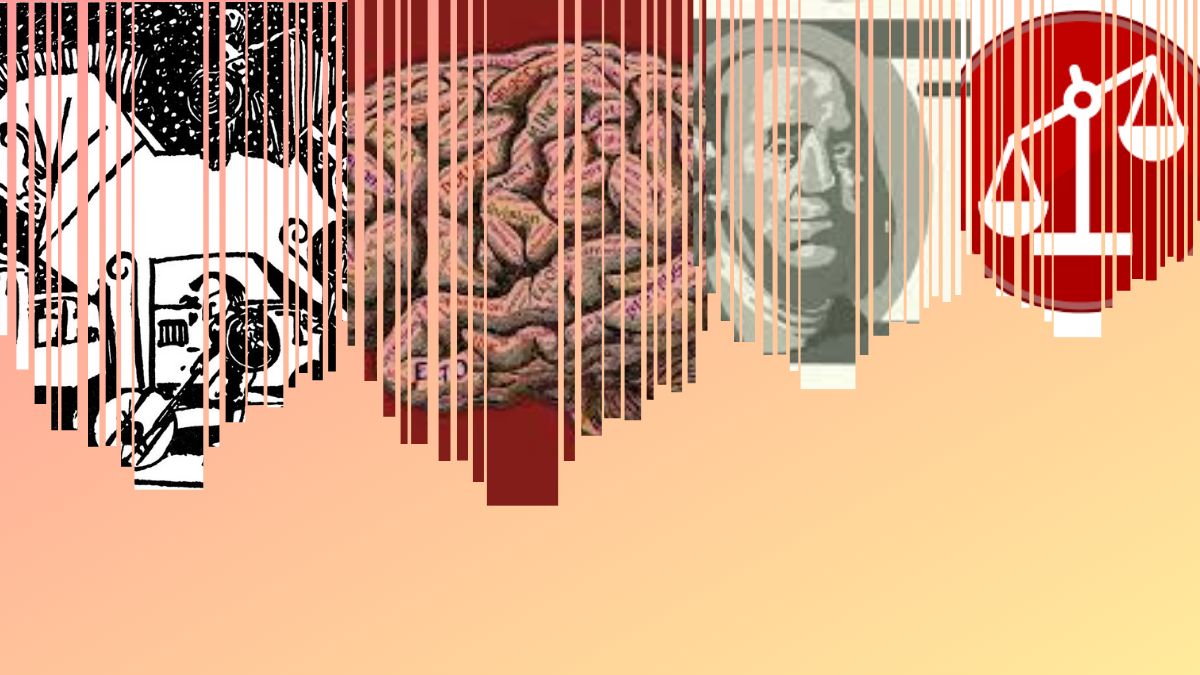






 A curated list of courses to learn data science, machine learning, and deep learning fundamentals.
A curated list of courses to learn data science, machine learning, and deep learning fundamentals.














































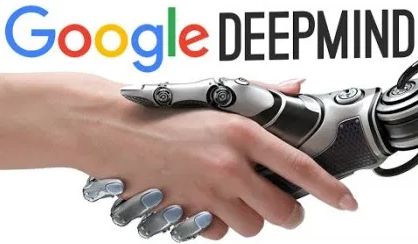














 People express a lot of fear when it comes to AI. Some worry AI will grow superhuman and kill us all. Others are concerned that AI lead automation will displace over 100 million workers and devastate the economy. Honestly, either may happen because the simple truth of AI is that when machines learn, humans lose control.
People express a lot of fear when it comes to AI. Some worry AI will grow superhuman and kill us all. Others are concerned that AI lead automation will displace over 100 million workers and devastate the economy. Honestly, either may happen because the simple truth of AI is that when machines learn, humans lose control.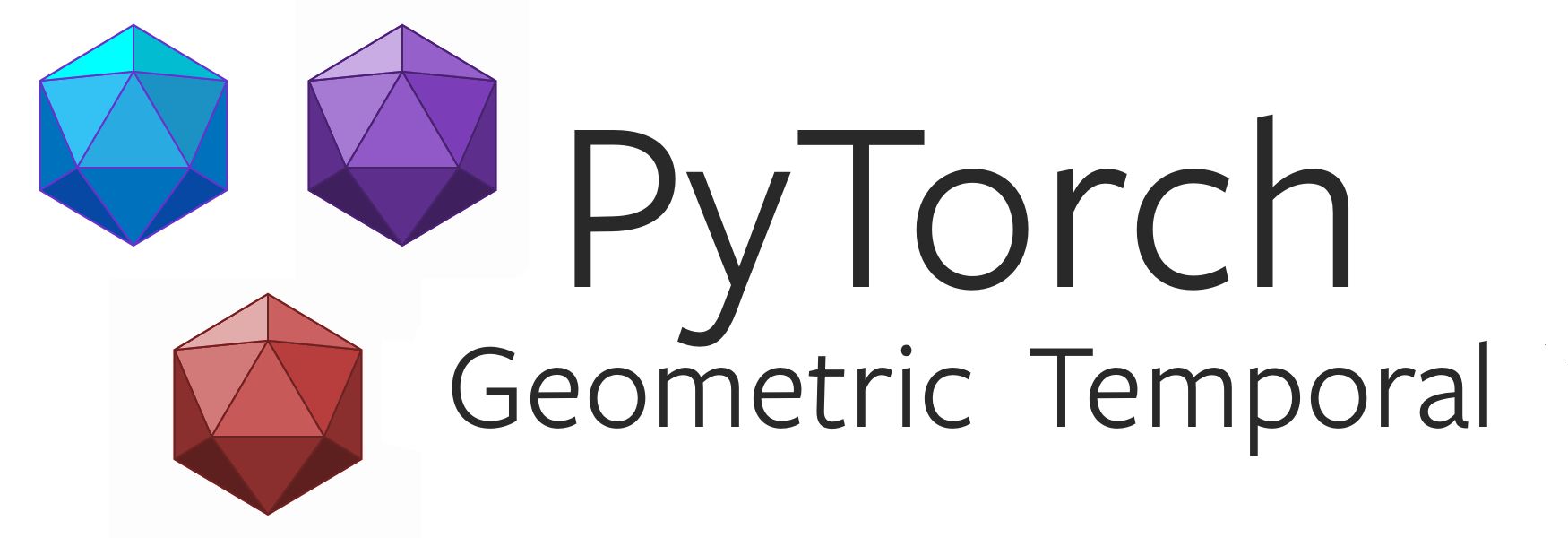





















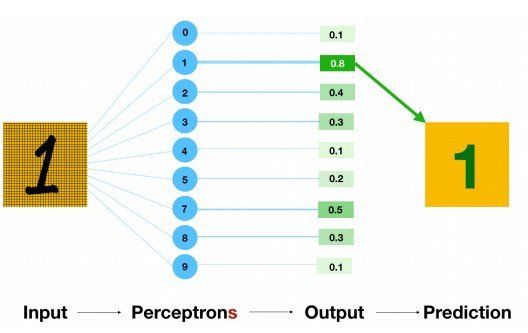











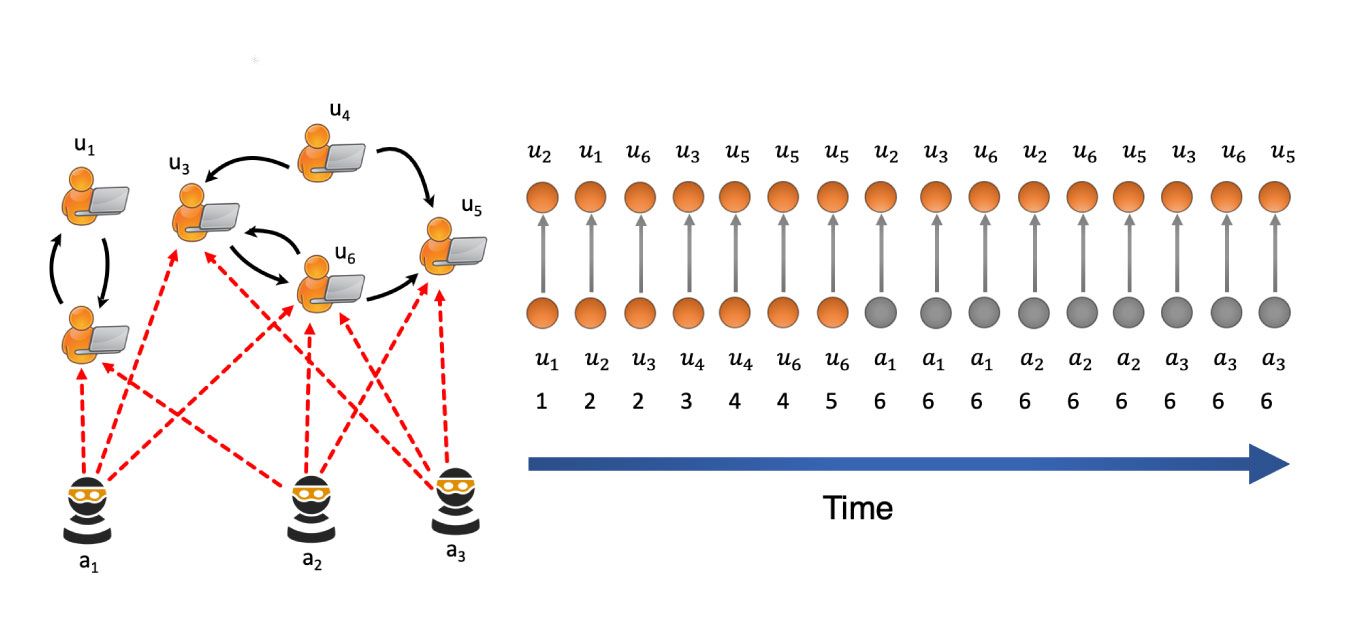










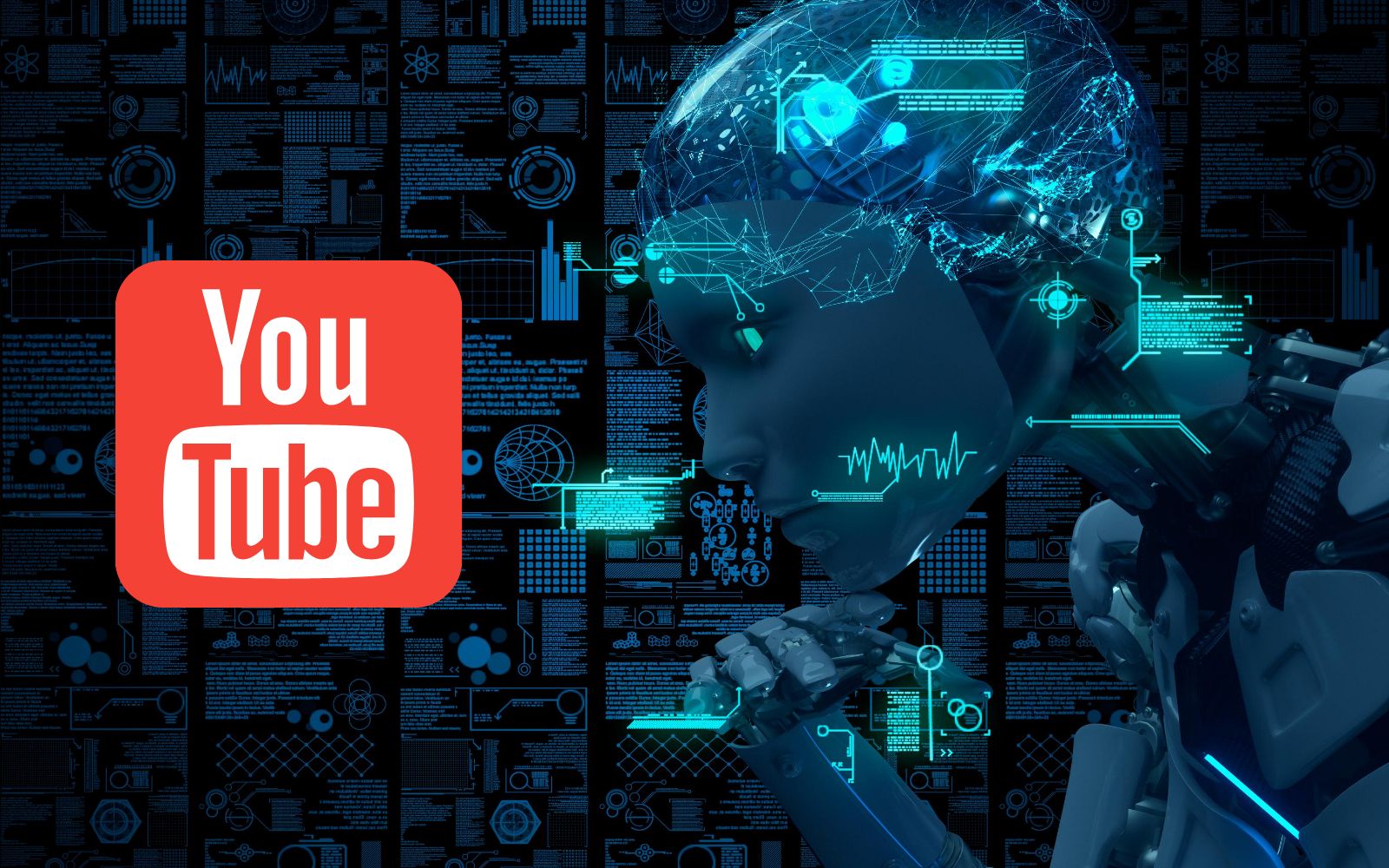











 Since the launch of My little company Neuroascent that I’ve Co-founded along with Rishi Bhalodia about a few months ago, We’ve reached a stage that now we’re ready to invest in a “Deep Learning Rig”.
Since the launch of My little company Neuroascent that I’ve Co-founded along with Rishi Bhalodia about a few months ago, We’ve reached a stage that now we’re ready to invest in a “Deep Learning Rig”.


















